RBI Monetary Policy Committee (MPC) cuts Repo Rate
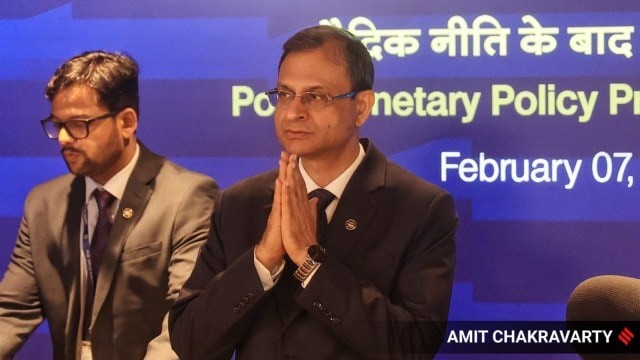
- 09 Feb 2025
In News:
In a landmark decision during its February 2025 meeting, the Reserve Bank of India’s (RBI) Monetary Policy Committee (MPC) reduced the repo rate by 25 basis points, from 6.5% to 6.25%, marking the first rate cut in five years (since May 2020). This move follows the Union Government’s recent cut in personal income tax, aimed at boosting consumption.
What is the Monetary Policy Committee (MPC)?
The MPC is a six-member statutory body responsible for setting India’s monetary policy. Its primary objective is price stability while ensuring economic growth. It meets bi-monthly to assess economic indicators and modify key policy rates like the repo rate, which influences overall borrowing and lending costs in the economy.
Key Highlights from the MPC Decision:
Repo Rate Cut:
- Reduced to 6.25% from 6.5%.
- Objective: Stimulate credit growth, investment, and consumer demand.
- Expected Impact: Lower EMIs for borrowers, reduced interest rates on EBLR and MCLR-linked loans.
GDP Growth Outlook (FY26):
- RBI projects 6.7% GDP growth for FY26.
- This is slightly higher than the FY25 estimate of 6.4%, and in line with the Economic Survey’s projection of 6.3–6.8%.
- Growth recovery is attributed to calibrated fiscal consolidation and stable private consumption.
Inflation Projections (CPI-based):
- FY26 Inflation Estimate: 4.2%
- Q1: 4.5%
- Q2: 4.0%
- Q3: 3.8%
- Q4: 4.2%
- CPI inflation had already dropped to 5.22% in December 2024, aided by easing food prices.
- RBI emphasized continued transmission of past policy measures and food price moderation as drivers of disinflation.
Broader Monetary Policy Context
- RBI will maintain a “neutral” policy stance to remain flexible amid evolving macroeconomic conditions.
- RBI Governor Sanjay Malhotra stressed that the inflation-targeting framework has helped stabilize prices, especially post-pandemic.
- The policy space was created by the simultaneous drop in inflation and moderate growth, allowing support for the economy without derailing price stability.
Cybersecurity & Digital Measures
- Additional Factor Authentication (AFA) introduced for international digital payments.
- Launch of exclusive domains:
- "bank.in" for Indian banks
- "fin.in" for the wider financial sector
These aim to bolster digital transaction security amid rising cyber fraud.
Forex & External Sector Outlook
- RBI reiterated that it does not target exchange rate levels, intervening only to curb excessive volatility.
- Ongoing global challenges include:
- Strengthening of the US dollar
- Higher bond yields
- Geopolitical tensions
- Threat of trade wars
- These have led to capital outflows, currency depreciation, and increased financial market volatility.
Conclusion
The RBI’s rate cut signals a strategic shift towards supporting economic growth amid global uncertainties. With a moderate inflation outlook and improving macroeconomic indicators, the decision is expected to boost domestic demand and investment, while reinforcing RBI’s commitment to price and financial stability.
India’s Pursuit of a Sovereign Foundational AI Model

- 08 Feb 2025
In News:
As artificial intelligence (AI) reshapes global economic, strategic, and technological landscapes, the question of whether India should build its own sovereign foundational AI model has gained prominence. Sovereign AI models—developed, trained, and deployed using domestic infrastructure, datasets, and expertise—are now seen as strategic assets, with countries like the US and China already establishing their own. India, however, remains dependent on foreign AI giants such as OpenAI, Google DeepMind, and Meta.
Why India Needs a Sovereign AI Model
1. Data Sovereignty and Security: India generates one of the world’s largest data pools, including sensitive data from healthcare, finance, and governance. Using foreign-built AI models risks privacy breaches and potential misuse. A homegrown model would ensure control over data and ethical AI deployment.
2. Reducing Foreign Dependence: Sovereign AI is crucial for applications in defense, cybersecurity, and governance, where reliance on foreign technology may undermine strategic autonomy. Sanctions or export controls could otherwise disrupt access to essential technologies like GPUs or software updates.
3. Cultural and Linguistic Alignment: Current global AI models are largely English-centric. A sovereign model trained on Indian languages and datasets would bridge the digital divide and make AI more inclusive. Projects like AI4Bharat’s IndicTrans2 and Sarvam AI’s Sarvam-1, a multilingual model built with Nvidia, exemplify this direction.
4. National Security and Innovation: Sovereign AI is essential in military intelligence, predictive security, and surveillance. It also fosters an innovation ecosystem, generating high-skilled jobs and encouraging academic-industry collaboration.
Challenges in Building Foundational AI Models
1. Infrastructure Gaps: India lacks cutting-edge chip manufacturing capabilities. With no agreements with firms like TSMC, India relies on imports of GPUs and processors, unlike countries developing supercomputers (e.g., Denmark’s Gefion, Japan’s AI Grid).
2. High Development Costs: Training a large AI model can cost millions. DeepSeek V3, for instance, cost $5.6 million for a single run, while India’s annual AI R&D budget remains modest compared to Big Tech’s $80 billion.
3. Fragmented Resources: Subsidized GPUs are spread thin across institutions, diluting their impact. Meta’s Llama 4, for example, used large dedicated clusters—unfeasible under current Indian frameworks.
4. Public R&D Inefficiencies: Bureaucratic red tape discourages risk-taking needed in AI research. Unlike flexible spending in firms like OpenAI, Indian R&D lacks autonomy and long-term funding.
Policy Recommendations and Way Forward
- Invest in IndiaAI Mission: Develop a national AI infrastructure with over 10,000 GPUs, secure cloud systems, and supercomputing clusters to train and deploy large-scale models.
- Build DPI for AI Builders: Create datasets, APIs, and platforms to support data annotation, fine-tuning, and delivery in Indian contexts.
- Adopt a Phased Approach: Focus on sovereign models in sensitive sectors (defense, healthcare) while using global open models for non-critical applications.
- Promote Public-Private Collaboration: Forge partnerships with companies like Nvidia or OpenAI for technology transfer and joint ventures.
- Encourage Innovation Under Constraints: India must emulate models like Alibaba or DeepSeek, which succeeded with limited resources and targeted innovations.
Conclusion
Building a sovereign foundational AI model is not merely a technological ambition but a strategic necessity. With coordinated efforts between government, industry, and academia, India can achieve AI self-reliance—ensuring data sovereignty, inclusive growth, and a strong global presence in the AI-driven future.
MSMEs in India’s Economic Growth
- 07 Feb 2025
In News:
In the Union Budget 2025–26, the Finance Minister proposed a significant policy shift by increasing the investment and turnover limits for MSME classification by 2.5 and 2 times respectively. This move is expected to enhance the growth prospects and scalability of India’s micro, small, and medium enterprises (MSMEs).
Economic Significance:
The MSME sector forms the backbone of the Indian economy, contributing 30% to the GDP and nearly 45% to manufacturing output. With over 1 crore registered units employing 7.5 crore people, it is the largest source of non-agricultural employment in the country. It plays a pivotal role in inclusive development, offering livelihood opportunities to the rural, urban poor, and semi-skilled workforce.
The formalization drive has been significant, with over 4 crore MSMEs registered on the Udyam portal by March 2024. Key schemes like PM Vishwakarma Yojana (?13,000 crore) and Mudra Yojana (?5.41 lakh crore disbursed in FY24) have supported artisans and first-time entrepreneurs, particularly women and marginalized communities.
Boost to Trade and Innovation:
MSMEs account for 45.73% of India’s total exports in sectors like textiles, leather, and engineering goods. Their integration into Global Value Chains (GVCs) is being facilitated by reforms in trade logistics, the GeM portal, and PLI schemes. Digital transformation is advancing rapidly, with 72% MSME transactions now digital, supported by platforms like ONDC and the RBI’s Public Tech Platform.
Women and Rural Empowerment:
Women entrepreneurs constitute 20.5% of Udyam registrations, and 68% of Mudra loans benefit them. MSMEs are also catalyzing rural industrialization by promoting agro-processing and curbing rural-urban migration through schemes like the SRI Fund and Animal Husbandry Credit Guarantee Scheme.
Key Challenges:
Despite their potential, MSMEs face critical bottlenecks:
- Credit access remains limited; only 20% of units access formal finance. Payment delays amounting to ?10.7 lakh crore (2022) hinder working capital.
- Regulatory burdens, inadequate infrastructure, and poor digital skills further constrain productivity.
- Low awareness of schemes and limited integration into global ESG standards affect competitiveness.
- The sector remains largely informal, weakening labor rights and policy outreach.
Recent Reforms & Recommendations:
To unlock MSMEs’ potential, a multi-pronged reform strategy is underway:
- Credit Measures: Promotion of cash-flow based lending, expansion of CGTMSE, Vyapar Credit Cards, and enhanced TReDS-GeM integration.
- Ease of Doing Business: Single-window clearances, self-certification, and stronger MSME facilitation councils.
- Digital & Skill Upgradation: Launch of Digital MSME 2.0, apprenticeship hubs, and innovation incubators.
- Market Access: Expansion of cluster-based models, branding support, and ONDC-GeM integration.
- Green MSMEs: ESG-linked credit, circular economy incentives, and green certifications.
- Formalization Push: Linking benefits to Udyam registration, backed by SIDBI-led equity support.
Conclusion:
MSMEs are central to India’s vision of a $5 trillion economy and Viksit Bharat by 2047. With increased investment thresholds, focused policy interventions, and digital empowerment, India can build a resilient, inclusive, and globally competitive MSME ecosystem.
Mental Health in India: Budget 2025–26

- 06 Feb 2025
In News:
The Union Budget 2025–26 marks a pivotal step towards strengthening mental health infrastructure in India. An allocation of ?99,858.56 crore to the Ministry of Health and Family Welfare (MoHFW) highlights the government’s recognition of health, including mental health, as a key pillar of national development.
Key Budgetary Allocations for Mental Health (2025–26)
- National Tele Mental Health Programme (NTMHP): Allocated ?79.6 crore to expand access to mental health services across the country.
- National Institute of Mental Health and Neurosciences (NIMHANS): Receives support to enhance research and treatment capacity.
- District Mental Health Programme: Implemented in 767 districts, providing training and outpatient services.
- Ayushman Arogya Mandirs: Over 1.73 lakh SHCs and PHCs are being upgraded to offer mental health services under comprehensive primary care.
Mental Health in India: Status and Burden
- As per WHO, mental health is the ability to realize one’s potential, cope with stress, work productively, and contribute to the community.
- India's Burden:
- 15% of adult Indians experience mental disorders (National Survey).
- Mental morbidity is highest in urban metros (13.5%), followed by rural areas (6.9%) and non-metro urban zones (4.3%).
- Global Burden (2019): Around 970 million people globally suffered from mental disorders, notably anxiety and depression.
- Treatment Gap: Estimated at 70% to 92%, particularly acute among blue-collar workers.
- Economic Impact: Mental health disorders result in significant productivity losses, often surpassing the direct cost of care.
Challenges in Mental Health Care in India
1. Budgetary and Policy Limitations
- The National Mental Health Programme (NMHP) faces funding ambiguities, often subsumed under broader health allocations.
- Limited enforcement of Mental Healthcare Act, 2017, despite mental health being a statutory right. Over 11 crore Indians suffer from mental disorders, yet 80% do not seek help.
2. Exclusion in Labour Laws
- The Occupational Safety, Health and Working Conditions Code (OSHWC), 2020, primarily covers physical safety. Mental health is not explicitly recognized.
- Phrases like “as far as reasonably practicable” limit employers’ obligations.
- The Code on Social Security (CSC), 2020, does not list mental strain as an occupational disease, making compensation for stress-induced conditions difficult.
3. Neglect of Blue-Collar Mental Health
- Mental health risks—long hours, poor conditions, job insecurity—affect blue-collar workers disproportionately.
- Workplace mental health programs (e.g., Infosys HALE, TCS EAP) are mainly for white-collar employees.
- Tele-MANAS, a government mental health helpline, requires voluntary calls. Low awareness and stigma among blue-collar workers dilute its effectiveness.
Policy and Structural Reforms Needed
- Legislative Frameworks:
- Amend OSHWC and CSC to explicitly include mental well-being and stress-related injuries as compensable conditions.
- Update the Third Schedule of the CSC to include mental health conditions, reducing dependence on case law.
- Awareness and Education:
- Launch mandatory employer-led awareness campaigns on programs like Tele-MANAS and Manodarpan.
- Community-based programs for early detection, support, and referral of mental health disorders.
- Inclusive and Tripartite Approach:
- Integrate employers, blue-collar workers, and mental health professionals into a unified framework under the new Labour Codes.
- Incorporate mental health indicators into occupational safety audits.
- Institutional Strengthening:
- Increase capacity-building efforts by training frontline health workers, general physicians, and non-specialist cadres in mental healthcare.
- Establish Centres of Excellence for mental health training and research.
Global and National Initiatives
- WHO Comprehensive Mental Health Action Plan (2013–2030): Focuses on integrating mental health into primary care and strengthening community-level interventions.
- Manodarpan Initiative: Aims at student mental health support under Atmanirbhar Bharat.
- Kiran Helpline: Government-run suicide prevention helpline for crisis support.
- Tele-MANAS Cells: 53 centers operational in 36 States/UTs, enhancing digital mental health care access.
Conclusion and Way Forward
The 2025–26 Budget reflects a progressive approach to mental health, particularly through investments in tele-counselling, primary care, and institutional support. However, significant gaps remain in policy, especially in addressing the mental health needs of blue-collar workers.
To transform “Satyamev Jayate” to “Shramev Jayate,” India must:
- Institutionalize rights-based mental health protection in labour legislation.
- Close the treatment gap through universal access and community-level awareness.
- Recognize mental health as integral to human capital and national productivity.
Only a comprehensive, inclusive, and rights-oriented approach will ensure mental health equity in India’s development journey.
Rapid Glacial Retreat in Arunachal Pradesh
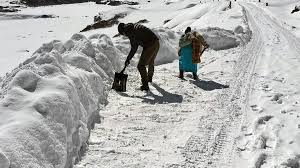
- 05 Feb 2025
In News:
A recent scientific study has revealed that the eastern Himalayas in Arunachal Pradesh have lost 110 glaciers between 1988 and 2020, highlighting a critical impact of climate change in the region.
Key Findings of the Study
- Glacier Loss: The number of glaciers declined from 756 to 646 over 32 years.
- Glacial Area Reduction: Total glacial cover reduced from 585.23 sq. km to 309.85 sq. km, indicating a loss of over 47%.
- Retreat Rate: Glaciers retreated at a rate of 16.94 sq. km per year.
- Elevation: Most glaciers were located at 4,500–4,800 metres above mean sea level on north-facing slopes of 15°–35°.
- Remote Sensing & GIS: The study used advanced tools along with the Randolph Glacier Inventory to track and analyze glacier boundaries.
- Glacial Lakes: Retreat has led to the formation of numerous glacial lakes, increasing the risk of Glacial Lake Outburst Floods (GLOFs), as seen during the 2023 Sikkim disaster which killed at least 55 people and damaged a 1,200 MW Teesta hydropower project.
Causes of Glacial Retreat
- Climate Change:
- The eastern Himalayas are warming faster than the global average.
- Temperature rise: Between 0.1°C and 0.8°C per decade.
- Over the last century, the region has experienced an increase of ~1.6°C.
- By 2100, projections indicate a 5–6°C temperature rise and 20–30% increase in precipitation.
- Black Carbon Deposition: Emissions from human activities (e.g., vehicles, biomass burning) deposit soot on ice, reducing reflectivity (albedo) and increasing heat absorption.
- Erratic Snowfall Patterns: Changes in precipitation reduce snow accumulation, weakening glacier sustenance.
- Geological Factors: Local topography, altitude, and rock composition also influence glacier stability and response to warming.
Implications of Glacial Retreat
- Water Security
- The Himalayas are known as the ‘Third Pole’, storing the largest volume of ice outside the polar regions.
- They are vital for sustaining over 1.3 billion people in South Asia by feeding major rivers (Indus, Ganga, Brahmaputra).
- Glacial retreat threatens long-term freshwater availability, agriculture, and urban water supplies.
- Hydropower and Infrastructure
- Changing river flow patterns due to glacial melt affect hydropower generation and irrigation systems.
- Risk of infrastructure damage from GLOFs is rising.
- Biodiversity and Agriculture: Altered ecosystems and climatic stress impact Himalayan biodiversity and disrupt traditional farming practices.
Himalayan Glaciers and River Systems
- Indus Basin: Originates from Lake Mansarovar; flows through Ladakh and Pakistan.
- Ganga Basin: Emerges from Gangotri Glacier in Uttarakhand; forms the Ganga after merging with Alaknanda.
- Brahmaputra Basin: Rises near Kailash range in Tibet; flows through Arunachal Pradesh, Assam, and Bangladesh.
Major Glaciers in India
Glacier Region Importance
Siachen Ladakh Longest glacier in India (76 km)
Gangotri Uttarakhand Source of the Ganga
Yamunotri Uttarakhand Origin of the Yamuna
Zemu Sikkim Largest glacier in Eastern Himalayas
Rathong Sikkim Feeds Teesta River
Milam Uttarakhand Source of Goriganga River
Pindari Uttarakhand Glacial trekking route
Glacial Lake Outburst Floods (GLOFs)
- GLOFs are sudden discharges of water from glacial lakes, often caused by moraine dam failures.
- These can trigger catastrophic downstream floods, threatening lives, infrastructure, and ecosystems.
Mitigation and Adaptation Strategies
- Climate Action: Drastic cuts in greenhouse gas emissions at national and global levels.
- Sustainable Water Management: Enhance glacier-fed river basin planning.
- Disaster Risk Reduction: GLOF early-warning systems, resilient infrastructure, and relocation policies.
- Community Participation: Local awareness, traditional knowledge integration, and eco-restoration efforts.
- International Cooperation: Transboundary initiatives under frameworks like the HKH (Hindu Kush Himalaya) Monitoring Network and UNFCCC.
RBI’s Liquidity Infusion of ?1.5 Lakh Crore

- 04 Feb 2025
In News:
In January 2025, the Reserve Bank of India (RBI) announced its largest monetary easing since the COVID-19 pandemic, unveiling a multi-pronged plan to inject over ?1.5 lakh crore into the money markets.
This move aims to address liquidity shortfalls caused by RBI’s forex interventions and signal possible easing in the upcoming monetary policy review.
Context: Why Liquidity Infusion Was Needed
- Forex Intervention: RBI sold over $50 billion from its foreign exchange reserves to stabilise the rupee, in response to large-scale equity sell-offs by Foreign Institutional Investors (FIIs).
- Impact: These interventions reduced rupee liquidity, tightened short-term interest rates, and raised borrowing costs.
- Liquidity Deficit: Market estimates pegged the shortfall at ?3 lakh crore.
Key Liquidity Measures Announced by RBI
- Government Bond Buy-Back: ?60,000 Crore
- Conducted in three tranches on January 30, February 13, and February 20, 2025.
- Objective: To inject liquidity into the banking system by repurchasing government securities before maturity.
- 56-Day Variable Rate Repo Auction: ?50,000 Crore
- Scheduled for February 7, 2025.
- Enables banks to borrow short-term funds by offering government securities as collateral at a market-determined interest rate.
- USD/INR Buy-Sell Swap Auction: $5 Billion
- A six-month forex swap in which RBI borrows dollars in exchange for rupees and agrees to buy them back later.
- Helps stabilize the rupee without draining rupee liquidity.
Significance of the Measures
- Monetary Transmission: With adequate liquidity, any potential repo rate cut will be more effectively transmitted through lower lending rates, boosting investment and consumption.
- Financial Stability: By calming money markets and moderating borrowing costs, RBI strengthens confidence amid global uncertainties.
- Rupee Management without Liquidity Squeeze: The forex swap allows rupee liquidity to remain intact while addressing exchange rate volatility.
Governor’s Focus Areas:
In a meeting with private sector bank heads ahead of the February monetary policy review, RBI Governor Sanjay Malhotra highlighted the following priorities:
- Financial Stability & Inclusion
- Enhanced Digital Literacy and Credit Access
- Improved Customer Service & Grievance Redressal
- Cybersecurity & IT Risk Management
- Monitoring of Third-party Service Providers
- Countering Rising Digital Fraud
Union Budget 2025–26
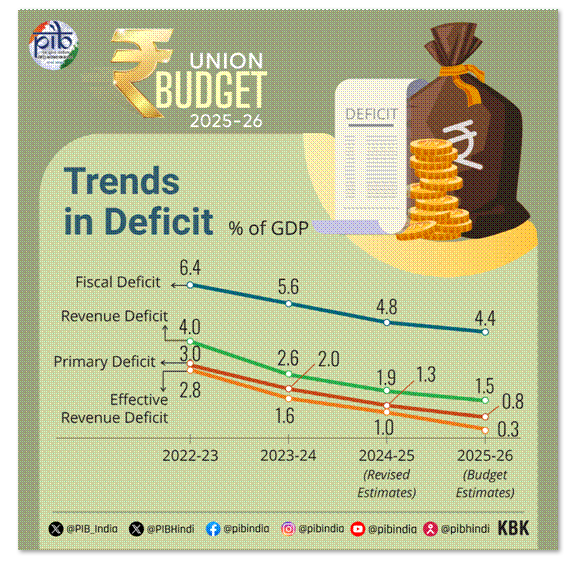
- 03 Feb 2025
In News:
Union Minister for Finance and Corporate Affairs Smt Nirmala Sitharaman presented Union Budget 2025-26 in the Parliament.
Key Highlights:
Fiscal Policy and Macroeconomic Indicators
- Total Expenditure: ?50.65 lakh crore
- Total Receipts (excl. borrowings): ?34.96 lakh crore
- Fiscal Deficit: 4.4% of GDP
- Gross Market Borrowing: ?14.82 lakh crore
- Capital Expenditure: ?11.21 lakh crore (3.1% of GDP)
Agriculture and Allied Sectors
- Prime Minister Dhan-Dhaanya Krishi Yojana: 100 low-productivity districts targeted; 1.7 crore farmers to benefit.
- Mission for Aatmanirbharta in Pulses: 6-year mission on Tur, Urad, and Masoor; NAFED/NCCF to procure for 4 years.
- Vegetables & Fruits Program: Comprehensive initiative for production, pricing, processing, and logistics.
- Makhana Board: New board in Bihar for production, value addition, and export.
- National Mission on High Yielding Seeds: To commercialize over 100 high-yielding seed varieties.
- Cotton Mission: 5-year initiative to boost productivity and Extra Long Staple (ELS) varieties.
- Fisheries: New EEZ and High Seas Framework focusing on Islands.
- Credit through KCC: Loan limit increased from ?3 lakh to ?5 lakh.
- Urea Plant in Assam: New plant at Namrup (12.7 lakh MT annual capacity).
MSMEs and Startups
- MSME Classification: Investment and turnover limits doubled (2.5x & 2x).
- Credit Cards for Micro Units: ?5 lakh limit; 10 lakh cards in year one.
- ?10,000 Cr Fund of Funds for Startups
- First-Time Entrepreneurs Scheme: Loans up to ?2 crore for 5 lakh women, SC/ST entrepreneurs.
- Footwear & Leather Sector Scheme: Aims ?4 lakh crore turnover and 22 lakh jobs.
- Toy Manufacturing Support: High-quality, eco-friendly toy ecosystem.
- Food Tech Institute: To be established in Bihar.
- National Manufacturing Mission: Across small, medium, and large units.
Infrastructure and Investment
- PPP Pipeline: 3-year project pipeline to be announced.
- ?1.5 lakh crore 50-year interest-free loans to states for CapEx.
- Urban Challenge Fund: ?1 lakh crore outlay; ?10,000 crore for FY26.
- Asset Monetization Plan 2025–30: Capital recycling worth ?10 lakh crore.
- Jal Jeevan Mission: Extended to 2028 with enhanced outlay.
- UDAN 2.0: Targeting 120 new destinations, 4 crore passengers in 10 years.
- Maritime Development Fund: ?25,000 crore; up to 49% govt contribution.
- Nuclear Energy Mission: ?20,000 crore outlay for Small Modular Reactors (SMRs).
- Greenfield Airports: Announced for Bihar.
Welfare and Social Security
- Saksham Anganwadi & Poshan 2.0: Enhanced nutritional cost norms.
- Medical Education: 10,000 new MBBS seats; 75,000 in 5 years.
- Day Care Cancer Centres: In all district hospitals; 200 in FY26.
- PM SVANidhi Revamp: ?30,000 UPI-linked credit cards.
- Online Platform Workers: E-Shram ID, PMJAY coverage.
- Urban Livelihood Scheme: For sustainable urban worker incomes.
Education and Skilling
- 50,000 Atal Tinkering Labs: Govt schools in 5 years.
- Bharatiya Bhasha Pustak Scheme: Digital books in Indian languages.
- National Skilling Centres of Excellence: With global partners.
- AI in Education: Centre of Excellence with ?500 crore outlay.
- IIT Expansion: Additional capacity for 6,500 students.
Innovation and R&D
- ?20,000 crore Innovation Fund (private-led R&D).
- Deep Tech Fund of Funds: For next-gen startups.
- PM Research Fellowships: 10,000 fellowships with higher support.
- 2nd Gene Bank: 10 lakh germplasm lines for food security.
- National Geospatial Mission
- Gyan Bharatam Mission: Conservation of 1 crore+ manuscripts.
Exports and Trade
- Export Promotion Mission: With ministerial and sectoral targets.
- BharatTradeNet (BTN): Unified platform for trade finance and docs.
- GCC Framework: Promote Global Capability Centres in Tier-2 cities.
Financial Sector Reforms
- FDI in Insurance: Raised from 74% to 100% for domestic investment.
- NaBFID Credit Enhancement Facility: For infra bonds.
- Grameen Credit Score: For SHGs and rural borrowers.
- Investment Friendliness Index: To rank states in 2025.
- Jan Vishwas Bill 2.0: Decriminalization of 100+ provisions.
- Tonnage Tax Extended: To inland vessels.
- Startups: Tax benefit eligibility extended to incorporation by 1 April 2030.
Taxation Reforms
Direct Taxes
- No Personal Tax: Income up to ?12 lakh (?12.75 lakh for salaried) under new regime.
- Revised Tax Slabs (New Regime):
- 0–4L: Nil | 4–8L: 5% | 8–12L: 10%
- 12–16L: 15% | 16–20L: 20% | 20–24L: 25% | 24L+: 30%
- Standard Deduction: ?75,000
- Compliance Relief: Trusts registration extended to 10 years.
- TDS/TCS Rationalization: Fewer thresholds, higher limits for senior citizens and rent.
- Tax Certainty: Safe harbour rules, startup extensions, presumptive taxation for electronics.
Indirect Taxes
- Tariff Rationalization: Only 8 remaining tariff rates.
- Customs Relief: ?2,600 crore forgone, key lifeline drugs exempted.
- Support to Domestic Manufacturing:
- EV/mobile battery manufacturing: 63 capital goods exempted
- Ships: BCD exemption extended for 10 years
- Marine, leather, textiles: Several BCD reductions/exemptions
- Voluntary Compliance Scheme: Without penalty for post-clearance corrections.
Geo-Economic Fragmentation (GEF)

- 02 Feb 2025
In News:
Geo-economic fragmentation refers to a policy-driven reversal of global economic integration, increasingly shaped by geopolitical alignments. It signifies a shift from globalization to strategically-driven economic blocs, where nations prioritize political alliances over market efficiency.
Key Characteristics
- Emergence of friend-shoring, re-shoring, and economic nationalism.
- Fragmentation of trade, capital flows, FDI, and migration.
- Retreat from multilateralism, with institutions like the WTO and IMF under stress.
- Strategic use of environmental, labor, and social standards by developed countries to impose uniform regulations, causing tensions.
Globalization to Fragmentation: Statistical Evidence
- Trade-to-GDP Ratio: Increased from 39% (1980) to 60% (2012); now threatened by rising protectionism.
- FDI Inflows: Rose from $54 billion (1980) to $1.5 trillion (2019); now increasingly concentrated among like-minded countries.
- Global Economy: Expanded from $11 trillion (1980) to over $100 trillion (2022).
- Trade Restrictions (WTO Report):
- 2023–24: 169 new measures covering $887.7 billion in trade.
- 2022–23: Covered $337.1 billion — shows a dramatic rise in protectionism.
- Over 24,000 new trade and investment restrictions imposed globally between 2020–24.
IMF on Costs of GEF
- Trade fragmentation could cause 0.2% to 7% GDP losses, especially for developing countries.
- Current fragmentation is more costly than Cold War era, as trade now constitutes 45% of global GDP (vs. 16% then).
- Less trade = less knowledge diffusion, innovation, and productivity gains.
Strategic Impacts: Global Supply Chains
China’s Dominance
- 80% of global battery manufacturing.
- 80% of solar panel components.
- 60% of wind turbine capacity.
- 70% of global rare earth mineral processing.
- Dominates EV supply chains, critical mineral refining, and clean energy manufacturing.
FDI Realignment
- FDI is increasingly relocating from China to India, Vietnam, Mexico, etc.
- Friend-shoring reduces capital access for emerging markets.
- Emerging economies face reduced FDI, slower growth, and technological decoupling.
India’s Strategic Response: Deregulation and Internal Growth
Policy Recommendations (Economic Survey 2024–25)
- Amplify deregulation to lower compliance costs and boost entrepreneurship.
- Empower SMEs to withstand global shocks and strengthen domestic manufacturing.
- Encourage inter-state learning for best practices in economic governance.
- Redouble efforts to boost exports and foreign investment amidst global volatility.
Rationale
- With the decline of global cooperation, internal engines of growth become crucial.
- Deregulation can unleash innovation, enhance productivity, and ensure resilient growth.
- India's response must be strategic, systematic, and state-inclusive to capitalize on this global transition.
Economic Survey 2024–25
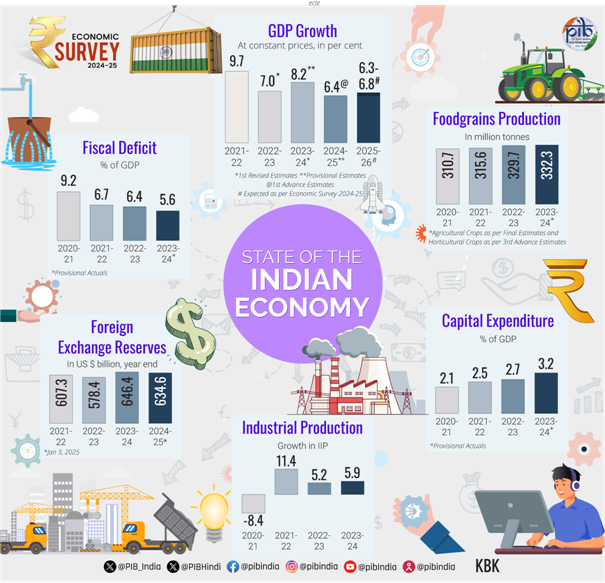
- 01 Feb 2025
In News:
- Released on 31st January 2025, a day before the Union Budget.
- Prepared by the Department of Economic Affairs, Ministry of Finance.
- Provides a comprehensive review of India’s macroeconomic trends, sectoral developments, and key policy challenges.
- Real GDP growth estimated at 6.4% in FY25 (close to decadal average); projected between 6.3–6.8% in FY26.
- Reflects India's resilience amidst global slowdown, supply chain disruptions, and geopolitical uncertainties.
Sector-wise Performance
Agriculture:
- Expected growth: 3.8% in FY25.
- Record Kharif foodgrain production: 1647.05 LMT (+5.7% YoY).
- Growth driven by horticulture, livestock, and fisheries.
- Supported by above-normal monsoons and robust reservoir levels.
Industry:
- Estimated growth: 6.2% in FY25.
- Construction, utilities, and mining contribute significantly.
- Challenges: Sluggish export demand, climate disruptions, and festival timing variations.
- Manufacturing PMI remains in the expansionary zone.
Services:
- Robust growth: 7.2% in FY25.
- Services exports up by 12.8% (April–Nov FY25) vs 5.7% in FY24.
- Growth led by finance, real estate, public administration, and professional services.
Inflation and Price Stability
- Retail inflation eased to 4.9% (Apr–Dec 2024) from 5.4% (FY24).
- Food inflation remains high at 8.4%, driven by pulses and vegetables.
- CPI expected to align with RBI's 4% target by FY26.
Investment and Infrastructure
- Capital Expenditure grew 8.2% YoY (Jul–Nov 2024); sustained increase since FY21.
- Infrastructure momentum:
- 2031 km railways commissioned (Apr–Nov 2024).
- 17 Vande Bharat trains introduced.
- Port efficiency improved; container turnaround time reduced from 48.1 to 30.4 hours.
- Renewable energy capacity rose by 15.8% YoY (Dec 2024).
External Sector and Trade
- Overall exports grew by 6% (Apr–Dec 2024); merchandise exports up 1.6%.
- Services exports surged; India now 7th largest globally.
- FDI inflows: $55.6 billion (Apr–Nov FY25), +17.9% YoY.
- Forex reserves at $640.3 billion (Dec 2024), covering 10.9 months of imports and 90% of external debt.
- CAD contained at 1.2% of GDP in Q2 FY25.
- Strong remittance inflows support BOP stability.
Fiscal Health
- Gross Tax Revenue rose 10.7% YoY (Apr–Nov 2024).
- Stable deficit indicators allowed for developmental expenditure.
- State revenue expenditure grew 12%, with subsidies increasing by 25.7%.
Banking, Credit, and Financial Markets
- Gross NPAs dropped to 2.6% (lowest in 12 years).
- CRAR of scheduled banks at 16.7% (Sept 2024), well above regulatory norms.
- Stock market cap to GDP ratio: 136%, higher than China (65%) and Brazil (37%).
- Credit-GDP gap reduced to -0.3% in Q1 FY25 (from -10.3% in Q1 FY23).
Employment and Labour Market
- Unemployment rate declined to 3.2% (2023-24) from 6.0% (2017-18).
- Labour Force Participation Rate (LFPR) and Worker-Population Ratio (WPR) improved.
- Emphasis on AI skill development to future-proof labour markets.
Health, Education & Social Sector
- Government health expenditure rose from 29% to 48% of total health spending (FY15–FY22).
- Out-of-pocket expenditure dropped from 62.6% to 39.4% in the same period.
- Education reforms aligned with NEP 2020 via programs like Samagra Shiksha, DIKSHA, PM SHRI, etc.
- Social services spending grew at 15% CAGR (FY21–FY25).
- Decline in Gini coefficient indicates improving consumption equality.
Policy Recommendations and Reform Agenda
- Deregulation as central theme to boost productivity and EoDB.
- Advocates Ease of Doing Business 2.0, led by states, targeting:
- Simplification of compliance norms.
- Risk-based regulation.
- Reduction in tariffs and licensing hurdles.
- ?50,000 crore Self-Reliant India Fund launched for MSME equity support.
- Need for long-term infrastructure investment to achieve Viksit Bharat@2047.
Global Backdrop
- Global GDP grew by 3.3% in 2023, with an average 3.2% growth projected over next five years (IMF).
- Weak global manufacturing; services sector remains stronger.
- Risks: Geopolitical tensions, trade policy fragmentation, energy transition dependence on China.
Way Forward
- Balanced outlook for FY26 with upside from:
- Strong rural demand.
- Agricultural recovery.
- Easing food inflation.
- Challenges include:
- Geopolitical tensions.
- Global trade and commodity price volatility.
- Delay in private investment materialisation.
Darfur Crisis: Humanitarian Emergency in Western Sudan
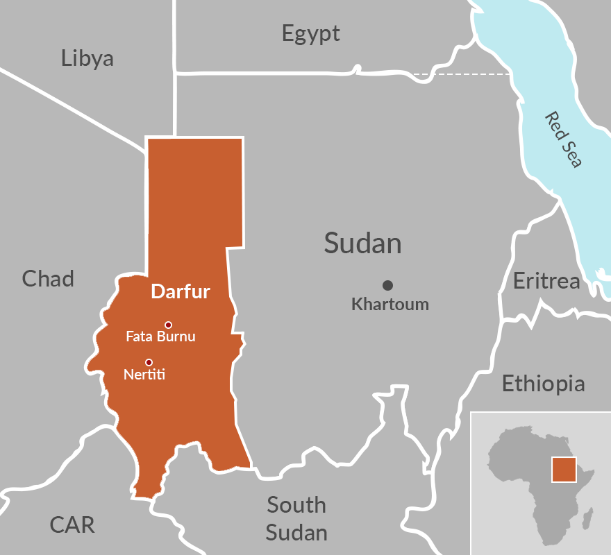
- 31 Jan 2025
Context:
Sudan’s Darfur region is once again in global focus following a deadly drone attack on the last functional hospital in El-Fasher, killing at least 67 people and injuring dozens. The International Criminal Court (ICC) has called for urgent UN Security Council intervention as the humanitarian situation deteriorates.
Geographical and Historical Background
- Location: Western Sudan, bordering Chad, Libya, Central African Republic, and South Sudan.
- Area: Approximately 493,000 sq. km, nearly the size of France.
- Topography: Predominantly arid and semi-arid terrain, with desert in the north and savanna in the south. Key physical features include:
- Jebel Marra Mountains: Volcanic highlands and key water source.
- Wadi Howar: Seasonal river vital for agriculture.
- Baggara Belt: Grazing zone, often contested.
- Historical Significance: Once an independent Islamic sultanate ruled by the Fur tribe, Darfur was annexed by Anglo-Egyptian Sudan in 1916. The name "Darfur" means "land of the Fur" in Arabic.
Ethnic Composition and Demographics
- Home to over 80 ethnic groups, including the Fur, Zaghawa, Beja, Nubians, and Arabs.
- Long-standing ethnic tensions exist between Arab nomadic groups and non-Arab farming communities, which have been a root cause of conflict.
Conflict Timeline and Key Actors
- Conflict Origins: Armed conflict began in 2003, led by rebel groups such as the Sudan Liberation Movement (SLM) and Justice and Equality Movement (JEM), demanding political autonomy and better representation.
- Government Response: The Sudanese government armed Janjaweed militias—now rebranded as the Rapid Support Forces (RSF)—who were accused of widespread atrocities, including genocide, mass killings, and rape.
- Recent Escalation:
- In 2023, violence surged amid civil war between Sudan's national army and RSF.
- RSF has seized much of Darfur and has besieged El-Fasher, capital of North Darfur, since May 2023.
- A January 2025 drone attack destroyed the Saudi Hospital in El-Fasher, killing 67 people. The hospital was one of the last with surgical capacity in the region.
Humanitarian Impact
- Health Crisis:
- 80% of healthcare facilities in Sudan are non-functional.
- Attacks on medical infrastructure have been rampant; El-Fasher’s Saudi Hospital was hit multiple times by suspected RSF drones.
- Displacement and Starvation:
- Over 12 million people displaced.
- Tens of thousands killed.
- Famine has already gripped camps like Zamzam, Abu Shouk, and Al-Salam, and is expected to spread to additional regions, including El-Fasher, by May 2025 (UN Assessment).
Global and Regional Implications
- The Darfur conflict has destabilized the region, affecting neighboring countries like Chad and the Central African Republic.
- ICC has issued warrants for several individuals including former President Omar al-Bashir, citing war crimes and crimes against humanity.
- The conflict highlights the intersection of climate stress, ethnic rivalries, political marginalization, and international accountability failures.
ASER 2024
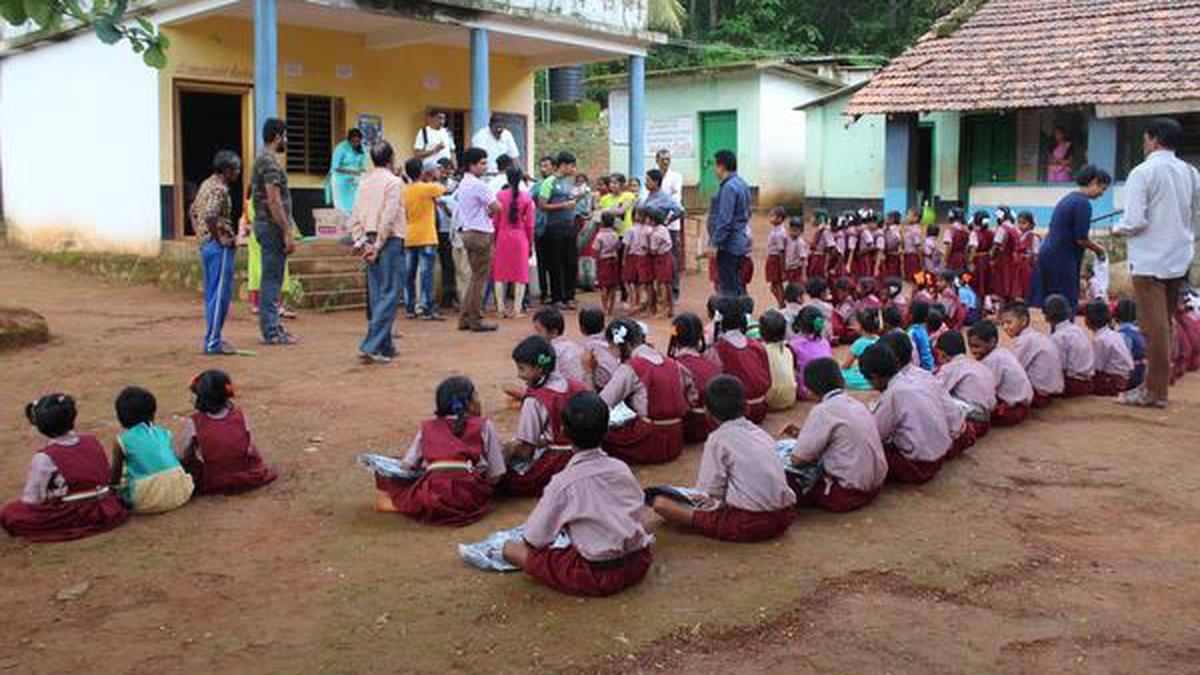
- 30 Jan 2025
In News:
The Annual Status of Education Report (ASER) 2024, released by the NGO Pratham, provides an insightful assessment of schooling and foundational learning levels across rural India.
Conducted in 17,997 villages across 605 districts, the survey reached over 6.49 lakh children aged 3–16 and tested more than 5 lakh for reading and arithmetic.
About ASER:
- Type: Household-based, citizen-led survey
- Initiated: 2005 (Annual till 2014; biennial since 2016)
- Scope:
- Tracks school enrollment (ages 3–16)
- Assesses basic reading and arithmetic skills (ages 5–16)
- Includes children in and out of school, across government, private, and informal institutions
- 2024: Introduced digital literacy assessment for ages 14–16
Key Findings of ASER 2024:
1. Enrollment Trends
- Pre-primary (Ages 3–5):
- Overall enrollment improved significantly.
- 3-year-old enrollment rose from 68.1% in 2018 to 77.4% in 2024.
- Anganwadis remain primary providers for 3–4-year-olds, while private preschools dominate among 5-year-olds.
- Elementary (Ages 6–14):
- Overall enrollment slightly declined from 98.4% (2022) to 98.1% (2024).
- Government school enrollment fell from 72.9% (2022) to 66.8% (2024).
- Private school enrollment, steadily rising since 2006, is regaining ground post-pandemic.
- Adolescents (Ages 15–16):
- Dropout rates fell from 13.1% in 2018 to 7.9% in 2024.
- However, female dropout (8.1%) remains higher than male.
2. Learning Outcomes
- Reading Skills:
- Std III: 23.4% in government schools could read Std II-level text (up from 16.3% in 2022).
- Std V: 44.8% could read Class II text, nearly matching 2018 levels (44.2%).
- Private schools yet to recover fully to pre-pandemic levels (59.3% in 2024 vs. 65.1% in 2018).
- Arithmetic Skills:
- Std III: 33.7% could perform basic subtraction (up from 25.9% in 2022, exceeding 28.2% in 2018).
- Std VIII: 45.8% could solve basic problems, showing consistent improvement.
Trend: Arithmetic recovery has outpaced reading, with government schools showing faster gains than private ones.
3. Digital Literacy (Ages 14–16)
- Access: Nearly 90% have access to smartphones.
- Ownership:
- 36.2% of boys own smartphones vs. 26.9% of girls.
- Usage:
- 82.2% use smartphones; only 57% for education, but 76% for social media.
- Safety Awareness:
- 62% know how to block/report users, and 55.2% can make profiles private.
4. School Infrastructure & Observations
- Attendance:
- Student attendance improved from 72.4% (2018) to 75.9% (2024).
- Teacher attendance rose from 85.1% to 87.5% in the same period.
- Facilities:
- Usable girls' toilets increased from 66.4% to 72%.
- Drinking water availability rose from 74.8% to 77.7%.
- Playground access remains stable (~66%).
- Learning Resources:
- Use of non-textbook reading materials (e.g., stories, folk tales) rose from 36.9% to 51.3%.
- Foundational Literacy and Numeracy (FLN):
- 80%+ of schools implemented FLN activities.
- 75% had at least one FLN-trained teacher.
Significance of Elementary Education:
- Foundational for Learning: Builds core skills vital for academic progression.
- Social Development: Encourages interaction, empathy, teamwork, and communication.
- Emotional and Cognitive Growth: Stimulates curiosity, motivation, and self-confidence.
- Economic Multiplier: Strong early education contributes to long-term national productivity and innovation.
Persistent Challenges:
- Infrastructure Deficits:
- Over 1.5 lakh schools lack functional electricity.
- 67,000 schools lack toilets; only 33.2% have usable disabled-friendly toilets.
- Technology Divide: Only 43.5% of government schools have computers vs. 70.9% in private schools.
- Human Resource Gaps: Around 1 lakh schools function with only one teacher.
- Social Barriers:
- Caste, class, rural-urban, and gender divides restrict equal educational access.
- Language barriers affect non-Hindi/English speakers due to lack of regional textbooks.
Key Government Initiatives:
- National Education Policy (NEP) 2020
- PM SHRI Schools
- Sarva Shiksha Abhiyan
- Mid-Day Meal Scheme
- Beti Bachao Beti Padhao
- National Programme on Technology Enhanced Learning (NPTEL)
- PRAGYATA (Guidelines for digital education
Way Forward:
- Early Interventions: Focus on retention among disadvantaged groups.
- Inclusive Learning Models: Introduce flexible/part-time programs for working children.
- Supplementary Literacy: Target out-of-school and dropout children with bridge courses.
- Local Governance: Establish District School Boards for planning and accountability.
- Infrastructure Expansion: Ensure school access within 1 km in underserved regions.
- Parental Awareness: Launch community campaigns on education's long-term benefits.
Union Budget: understanding its formulation and implications

- 29 Jan 2025
What is the Union Budget?
The Union Budget, referred to as the Annual Financial Statement under Article 112 of the Constitution, outlines the government's estimated receipts and expenditure for a financial year. It serves as a crucial instrument for economic policy and governance.
The Budget Division of the Department of Economic Affairs under the Ministry of Finance is responsible for preparing the Union Budget.
Key Components of the Budget
1. Expenditure
Expenditure is classified on the basis of:
- Asset Creation and Liability Reduction:
- Capital Expenditure: Increases assets or reduces liabilities (e.g., infrastructure, hospitals).
- Revenue Expenditure: Does not create assets (e.g., salaries, subsidies, interest payments).
- Sectoral Impact:
- General Services: Administrative functions, defence, interest payments.
- Economic Services: Agriculture, transport, rural development, etc.
- Social Services: Education, health, welfare.
- Grants-in-Aid and Contributions.
Development Expenditure = Economic Services + Social Services, and it too can be capital or revenue in nature.
2. Receipts
Government receipts are classified into:
- Revenue Receipts: Do not create liabilities (e.g., tax and non-tax revenues).
- Non-Debt Capital Receipts: Do not involve liabilities (e.g., loan recovery, disinvestment).
- Debt-Creating Capital Receipts: Involve future liabilities (e.g., borrowings).
3. Deficit Indicators
- Fiscal Deficit = Total Expenditure - (Revenue Receipts + Non-Debt Capital Receipts)
- Primary Deficit = Fiscal Deficit - Interest Payments
- Revenue Deficit = Revenue Expenditure - Revenue Receipts
Fiscal deficit reflects the net borrowing requirement of the government.
Implications of the Budget on the Economy
1. Aggregate Demand
- Government Expenditure boosts aggregate demand.
- Tax and Non-Tax Revenue reduces disposable income, thereby contracting demand.
Policy Interpretations:
- Expansionary Fiscal Policy: Rise in expenditure-GDP ratio, increase in fiscal deficit.
- Contractionary Fiscal Policy: Increase in revenue-GDP ratio, reduction in fiscal deficit.
2. Income Distribution
- Revenue expenditure like food subsidies or MGNREGA supports lower-income groups.
- Corporate tax concessions benefit businesses. Both may increase deficits but differ in their distributional impact.
Fiscal Rules and Their Role
Fiscal rules define policy targets to maintain macroeconomic stability. They guide the government’s borrowing and spending behaviour.
Current Framework in India
India’s fiscal framework is guided by the N.K. Singh Committee Report, which recommended:
- Stock Target: Maintain a specific Debt-to-GDP ratio.
- Flow Target: Limit Fiscal Deficit-to-GDP ratio.
- Composition Target: Maintain Revenue Deficit-to-GDP ratio.
Challenges in Implementation
- India’s tax rates are largely fixed and not adjusted frequently.
- To meet fiscal targets, the government primarily adjusts expenditure.
- This rigidity may constrain the ability to undertake expansionary fiscal policy, especially during economic downturns or rising unemployment.
Need for Re-examination
Given persistent issues like low growth and unemployment, current fiscal rules may hinder responsive policy action. A flexible and context-specific fiscal framework is essential for ensuring both macroeconomic stability and inclusive development.
Conclusion
The Union Budget is not merely a financial statement but a tool of economic management. A nuanced understanding of its formulation, components, and policy implications is vital for evaluating government priorities and their impact on the economy and society.
Addressing Environmental Challenges and Strengthening Regulations in India
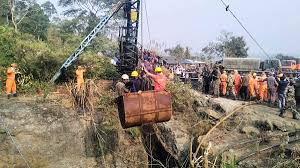
- 28 Jan 2025
In News:
India's recent coal mining tragedy in Dima Hasao, Assam, underscores the nation's ongoing struggle with illegal and hazardous rat-hole mining, despite the National Green Tribunal's 2014 ban. This persistent exploitation, driven by industrial demand for coal, highlights the gap between environmental regulations and their enforcement, revealing a broader issue of balancing economic growth with environmental protection. As India strives to meet ambitious climate goals and sustain economic development, strengthening environmental regulations becomes critical.
Current Environmental Regulations in India
India has established a strong legal framework to protect its environment, grounded in the Indian Constitution. Articles 48A and 51A(g) direct the state and citizens to safeguard the environment, while Article 21 ensures the right to a clean and healthy environment, as interpreted by the Supreme Court. Key pollution control laws include:
- Water (Prevention and Control of Pollution) Act, 1974: Regulates water pollution and establishes pollution control boards at the national and state levels.
- Air (Prevention and Control of Pollution) Act, 1981: Controls air pollution from industrial emissions and vehicles.
- Environment (Protection) Act, 1986: Provides overarching powers for environmental protection.
- Plastic Waste Management Rules, 2016: Regulates plastic waste disposal and bans single-use plastics.
Other significant laws focus on forest and wildlife protection, including the Indian Forest Act, 1927, and the Wildlife (Protection) Act, 1972, along with the National Green Tribunal (NGT) Act, 2010, which ensures quick resolution of environmental disputes.
Key Issues with Enforcement
- Despite these stringent regulations, enforcement remains weak due to institutional limitations. Many industrial units fail to meet environmental standards, with regulatory bodies underfunded and understaffed. For example, pollution control boards in states like Uttar Pradesh and Bihar are plagued by staffing shortages, hampering their ability to monitor pollution effectively.
- Inadequate public participation and insufficient technology adoption further exacerbate these challenges.
- The Environmental Impact Assessment (EIA) process, often bypassed or diluted, leads to development projects being approved without full consideration of their environmental impacts, particularly in ecologically sensitive areas.
Weak Enforcement and Conflict between Development and Conservation
The tension between development and conservation is evident in policies that relax environmental regulations for economic growth. The Forest (Conservation) Amendment Act, 2023, prioritizes infrastructure projects over forest preservation, undermining ecological conservation. Moreover, the rapid urbanization of cities like Gurugram and Faridabad has led to large-scale deforestation and a reduction in natural conservation zones, worsening air and water quality.
Strengthening Environmental Regulations
To address these challenges, India needs to strengthen its environmental regulatory mechanisms:
- Enhance Enforcement: Adequate funding, skilled personnel, and advanced technology, such as AI-based pollution monitoring and drone surveillance, are essential to improve compliance.
- EIA Reforms: The EIA process should be made more transparent and participatory, ensuring that marginalized communities are included in decision-making.
- Promote Clean Energy: Expanding subsidies for renewable energy and encouraging industries to adopt green technologies will help reduce reliance on fossil fuels.
- Circular Economy: Encouraging industries to adopt recycling and upcycling practices can minimize waste and reduce resource extraction.
- Strengthen Local Involvement: Empowering local communities through decentralization under the Forest Rights Act will ensure more inclusive environmental governance.
Conclusion
India’s environmental challenges require a balanced approach, integrating sustainable development with robust environmental protections. Strengthening regulatory enforcement, reforming the EIA process, and fostering community-led conservation are essential to aligning economic growth with environmental sustainability. By addressing these gaps, India can better navigate its path toward achieving both its development goals and climate commitments.
India-Indonesia Relations
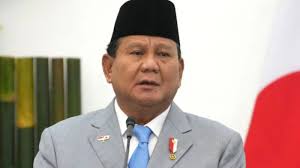
- 27 Jan 2025
In News:
The President of Indonesia, visited India as the Chief Guest for the 76th Republic Day in January 2025. This marked the 75th anniversary of diplomatic ties, reaffirming the commitment to deepen cooperation in economic, strategic, cultural, and defense domains.
Historical Foundations
- Ancient Civilizational Links: Trade and cultural exchanges date back to the 2nd century BCE, reflected in the influence of Hinduism and Buddhism on Indonesian society (e.g., Ramayana, Mahabharata, Borobudur, Prambanan).
- Modern Diplomatic Ties:
- Formalized in 1950, with a Treaty of Friendship in 1951.
- Collaborated in the 1955 Bandung Conference and co-founded the Non-Aligned Movement (1961).
- Indonesia’s first President Sukarno was the Guest of Honour at India’s first Republic Day in 1950.
- Cold War and Beyond:
- Relations cooled in the 1960s but revived in the 1980s.
- The 1991 'Look East' Policy and the 2014 'Act East' Policy revitalized ties.
- Strategic Partnership in 2005; upgraded to a Comprehensive Strategic Partnership in 2018.
Key Pillars of Cooperation
- Economic and Trade Relations
- Trade Volume: Reached USD 38.8 billion (2022–23), targeted to increase to USD 50 billion by 2025.
- Key Imports: India imports coal, palm oil, and nickel.
- Investment: Indian investments in Indonesia total USD 1.56 billion in infrastructure, textiles, and energy.
- New Developments:
- MoU on Local Currency Settlement Systems to reduce dependency on USD.
- Focus on resolving trade barriers via forums like WGTI and BMTF.
- Cooperation in critical minerals like nickel and bauxite.
- BPCL to invest USD 121 million in the Nunukan gas block.
- Military Exercises: Garuda Shakti (Army), Samudra Shakti (Navy), and participation in Milan, Komodo, Super Garuda Shield, etc.
- Key Agreements:
- 2018 Defense Cooperation Agreement.
- White Shipping Information Exchange (WSIE).
- Proposal for Bilateral Maritime Dialogue and Cyber Security Dialogue.
- Joint vision on maritime cooperation under SAGAR (Security and Growth for All in the Region).
- BrahMos Deal: Talks underway for Indonesia’s acquisition of BrahMos missiles (~USD 450 million).
- Cultural Diplomacy: Shared heritage of Hindu-Buddhist traditions; India assisting in restoring Prambanan temple.
- Tourism & Connectivity: Direct flights since 2023; India is the second-largest source of tourists to Bali.
- New Initiatives:
- Cultural Exchange Programme (2025–2028).
- India reaffirmed the Kashi Cultural Pathway for heritage restoration and repatriation of artifacts.
- Science, Technology, and Space
- ISRO supports Indonesia’s satellite ambitions; agreement on Biak Tracking Station.
- Renewed MoU on STEM cooperation.
- Areas of collaboration: Quantum tech, high-performance computing, and digital public infrastructure.
- Energy and Health Security
- Collaboration on biofuels under the Global Biofuels Alliance.
- Joint initiatives on mid-day meals and public distribution systems.
- MoUs on digital health, capacity building, and traditional medicine.
Multilateral and Regional Cooperation
- ASEAN & Indo-Pacific: Commitment to ASEAN centrality and cooperation through IPOI, India-Indonesia-Australia Trilateral, and ASEAN-India outlook.
- Global Platforms: Collaboration in BRICS, G20, IORA, and advocacy for the Global South.
- Climate & Disaster Resilience:
- Joint efforts under CDRI.
- Indonesia invited to the International Solar Alliance and Big Cat Alliance.
Key Challenges
- Trade Imbalance: Heavy reliance on limited imports (coal, palm oil); imbalance persists as Indonesia’s trade with China is far greater (~USD 139 billion).
- Bureaucratic & Regulatory Barriers: Slow progress on infrastructure and investment due to permit and regulatory issues.
- Geopolitical Pressures: Indo-Pacific instability and China's expanding influence pose strategic challenges.
- Logistical Constraints: Inadequate connectivity infrastructure hinders deeper integration.
Way Forward
- Trade Diversification: Include sectors like tech, agriculture, and green energy.
- Defense Deepening: Expand joint exercises, maritime patrols, and intelligence-sharing.
- Enhance Connectivity: Boost air, sea, and digital linkages for trade and tourism.
- Green Collaboration: Advance renewable energy and sustainable mining ventures.
- Cultural & Educational Engagement: Promote student exchanges, scholarships (e.g., ITEC), and diaspora involvement.
Conclusion
India and Indonesia share deep-rooted civilizational links and are strategically aligned in the Indo-Pacific. Their evolving Comprehensive Strategic Partnership encompasses trade, defense, technology, and cultural diplomacy. Strengthening this partnership will not only boost bilateral growth but also ensure a stable, multipolar, and cooperative regional order.
External Commercial Borrowings (ECBs)
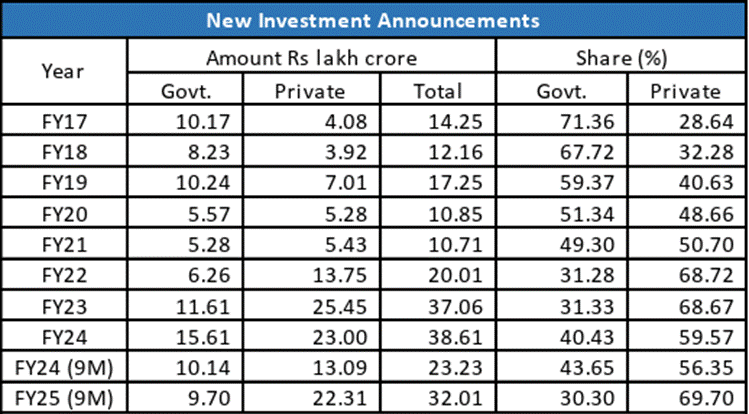
- 25 Jan 2025
In News:
A recent State Bank of India (SBI) report highlights the evolving trends in investment activity and the increasing importance of External Commercial Borrowings (ECBs) in financing India's economic growth. It also reflects rising private sector participation and a robust capital formation trend.
Investment Trends in India:
- Total Investment Announcements reached ?32.01 lakh crore during April–December 2024 (9MFY25), up 39% from the same period in FY24.
- The private sector accounted for 70% of investments in 9MFY25, up from 56% in FY24, indicating rising business confidence.
- Gross block of Indian corporates rose to ?106.5 lakh crore (March 2024), from ?73.94 lakh crore in March 2020—an addition of over ?8 lakh crore annually.
- Capital Work in Progress stood at ?13.63 lakh crore, reflecting ongoing infrastructure and industrial projects.
- Household Net Financial Savings (HNFS) improved to 5.3% of GDP in FY24 from 5.0% in FY23.
- Investment-to-GDP ratio improved, with:
- Government investment at 4.1% of GDP (FY23) — highest since FY12.
- Private corporate investment rising to 11.9% in FY23, projected to reach 12.5% in FY24.
What are External Commercial Borrowings (ECBs)?
ECBs refer to loans raised by Indian entities from foreign lenders, including commercial banks, export credit agencies, and institutional investors. These borrowings are regulated by the Reserve Bank of India (RBI) and used for purposes like capital expansion, modernization, and infrastructure development.
Current Status of ECBs (as of Sept–Nov 2024):
- Outstanding ECBs stood at $190.4 billion (Sept 2024).
- Private sector share: 63% (~$97.6 billion).
- Public sector share: 37% (~$55.5 billion).
- Of the total, non-Rupee and non-FDI ECBs accounted for $154.9 billion.
- ECBs registered (April–Nov 2024): $33.8 billion, mainly for capital goods import, local capex, and new projects.
- Cost of ECBs declined to:
- 6.6% average during April–November 2024.
- 5.8% in November 2024, down by 71 basis points from the previous month.
- Hedging practices: Private companies hedge about 74% of their ECB exposure, essential for managing currency risk.
Why Are ECBs Important for India?
- Bridging Capital Gaps: Domestic markets may not meet the capital needs of large projects.
- Lower Interest Rates: ECBs often offer cheaper financing than domestic loans.
- Infrastructure Financing: Key source of funds for sectors needing long-term investment.
- Foreign Exchange Access: Supports imports, modernization, and technology adoption.
- Private Sector Expansion: Enables firms to grow, diversify, and remain globally competitive.
Challenges and Risks:
- Currency Risk: Rupee depreciation can raise repayment costs.
- Interest Rate Risk: Linked to global rates (e.g., LIBOR/SOFR), which can rise unpredictably.
- Hedging Costs: Though necessary, hedging adds to borrowing costs.
- Global Dependency: Exposure to international financial volatility.
- Regulatory Constraints: RBI norms on end-use, maturity, and cost ceilings can reduce flexibility.
- Over-Borrowing Risk: Mismanagement can lead to unsustainable debt levels and strain forex reserves.
Clarification on ECB Liability Data:
- Some media reports mistakenly cited India’s ECB stock as $273 billion.
- The actual ECBs, as per RBI (Sept 2024), stand at $190.4 billion.
- The inflated figure includes $72 billion in FPI (Debt), which should not be classified as ECBs.
Way Forward:
- Regulatory Refinement: Simplify ECB rules for strategic sectors and long-term projects.
- Encourage Hedging: Make risk management more affordable and accessible.
- Prudent Borrowing: Promote ECBs for infrastructure, exports, and modernization rather than working capital.
- Monitoring and Oversight: Ensure transparency and prevent over-leverage.
- Strengthen Domestic Financing: To reduce overdependence on foreign borrowing.
National Health Mission (NHM): 2021–2024
- 24 Jan 2025
In News:
The Union Cabinet reviewed the progress under NHM (2021–24), underscoring significant gains in public health infrastructure, disease control, and healthcare accessibility, particularly during and after the COVID-19 pandemic.
About NHM:
- Launched: 2013, integrating NRHM (2005) and NUHM (2012).
- Objective: Universal access to equitable, affordable, and quality healthcare services.
- Focus: Vulnerable populations, rural and urban poor.
- Implementation: Ministry of Health & Family Welfare supports states and UTs.
Key Achievements (2021–2024):
1. Human Resource Expansion
- 12.13 lakh healthcare workers added, including doctors, nurses, CHOs, and AYUSH practitioners.
- Ni-kshay Mitras: 1.56 lakh volunteers supported 9.4 lakh TB patients.
- Progressive annual engagement:
- FY 2021–22: 2.69 lakh
- FY 2022–23: 4.21 lakh
- FY 2023–24: 5.23 lakh
Maternal and Child Health
- Maternal Mortality Ratio (MMR): Dropped by 83% since 1990 (from 130 to 97 per lakh live births).
- Under-5 Mortality Rate (U5MR): Reduced from 45 (2014) to 32 (2020).
- Infant Mortality Rate (IMR): Declined from 39 (2014) to 28 (2020).
- Total Fertility Rate (TFR): Reduced from 2.3 (2015) to 2.0 (2020).
Disease Control and Elimination
- Tuberculosis (TB):
- Incidence: From 237 (2015) to 195 (2023) per 1,00,000.
- Mortality: Decreased by 21.4% (from 28 to 22).
- Kala-azar: Target achieved in all endemic blocks (<1 case/10,000 population by 2023).
- Sickle Cell Anemia: 2.61 crore people screened under the National Elimination Mission.
- Malaria:
- Cases fell in 2021 but rose in 2022 and 2023.
- Deaths declined continuously.
Immunization Campaigns
- COVID-19: Over 220 crore doses administered (2021–2024).
- Measles-Rubella: 97.98% coverage, vaccinating 34.77 crore children under IMI 5.0.
- Digital Health: U-WIN platform launched in 2023 for real-time vaccination tracking in 65 districts.
Healthcare Infrastructure
- 7,998 health facilities certified under National Quality Assurance Standards (NQAS).
- Ayushman Arogya Mandirs: 1.72 lakh operational, with 1.34 lakh offering 12 essential services.
- 24×7 services: At 12,348 PHCs and 3,133 FRUs.
- Mobile Medical Units (MMUs): Expanded to 1,424 units, MMU Portal operational.
Specialized Health Initiatives
- Pradhan Mantri TB Mukt Bharat Abhiyan: Volunteer-driven TB patient support.
- Pradhan Mantri National Dialysis Programme:
- Delivered 62.35 lakh hemodialysis sessions to 4.53 lakh patients in FY 2023–24.
- Sickle Cell Mission: Major tribal health initiative targeting elimination by 2047.
National Programs Under NHM
- RMNCH+A: Reproductive, Maternal, Newborn, Child, and Adolescent Health.
- Communicable Disease Control: TB, malaria, leprosy, HIV/AIDS.
- Non-Communicable Diseases (NCDs): Cancer, diabetes, hypertension.
- Other Initiatives: Rashtriya Bal Swasthya Karyakram (RBSK), PM National Dialysis Programme, Ayushman Bharat (AB-PMJAY).
Alignment with SDG Goals
- NHM achievements indicate India is on track to meet SDG-3 targets (Good Health and Well-being), especially in maternal and child mortality reduction.
Judiciary in Crisis and the Digital Transformation of India

- 23 Jan 2025
In News:
The Indian judiciary is grappling with an unprecedented backlog of cases, while India’s digital economy is witnessing exponential growth, promising to be a key driver of future economic expansion. Simultaneously, India's strides in the space sector and emerging technologies signal its increasing role as a global innovator.
The Crisis of Judicial Pendency in India
- Background: The Supreme Court recently permitted High Courts to appoint ad-hoc retired judges under Article 224A to address the mounting pendency of cases. This move revives a constitutional provision that had remained dormant, with only three recorded instances of its use.
- Scale of Backlog:
- As of January 2025, over 62 lakh cases are pending in High Courts.
- Nearly 4 crore cases are pending in subordinate courts.
- 30% of High Court judicial positions remain vacant.
- Reasons for Pendency
- Insufficient Judicial Strength: Low judge-to-population ratio.
- Infrastructure Deficit: Poor court facilities, especially in rural areas.
- Administrative Delays: Outdated systems and slow bureaucratic processing.
- Rising Litigation: Increase in public awareness and socio-economic issues.
- Adjournments & Procedural Delays: Inefficient court practices.
- Vacancies in Appointments: Delay in filling judicial posts due to the standoff between executive and judiciary.
Constitutional Provision: Article 224A
- Enables High Courts to appoint retired judges temporarily with the President’s consent.
- Judges appointed under this article have full powers and jurisdiction of a regular High Court judge.
- Supreme Court in Lok Prahari v. Union of India (2021) provided guidelines for such appointments, including limiting it to instances where judicial vacancies are not more than 20%.
Judicial Appointments Debate: Collegium vs. NJAC
- Collegium System
- CJI + Four senior-most judges decide appointments.
- Criticized for lack of transparency, nepotism, and non-accountability.
- National Judicial Appointments Commission (NJAC)
- Proposed inclusion of judiciary, executive, and civil society (2 eminent persons).
- Struck down by SC in 2015 to preserve judicial independence.
- Current Debate: Rising demands for a reformed NJAC to bring in accountability while retaining independence.
Global Models of Judicial Appointments
Country System Key Feature
UK Judicial Appointments Commission Transparent, includes laypersons
South Africa Judicial Service Commission Diverse representation: judiciary, politicians, academics
France High Council of Judiciary Balanced approach with civil society input
Impacts of Judicial Delay
- Delayed Justice: Undermines public trust.
- Overcrowded Prisons: Over 70% of inmates are undertrials; prisons operate at 114% capacity.
- Economic Costs: Delays in dispute resolution hamper business environment and economic efficiency.
- Judicial Burnout: Overburdened judges impact quality of judgments.
Addressing Judicial Pendency
- Short-Term Measures
- Appointment of Ad-Hoc Judges under Article 224A.
- Fast Track Courts for specific offenses (e.g., crimes against women, corruption).
- Long-Term Reforms
- Reforming Judicial Appointments: Transparent and accountable system through restructured NJAC.
- Enhancing Collegium Transparency: Clear criteria and public disclosure.
- Promoting ADR Mechanisms: Arbitration, mediation, and conciliation to reduce court burden.
- Judicial Infrastructure Development: More courtrooms, modern facilities, and digitalization.
Way Forward
Judicial Reform
- Strengthen judicial accountability while maintaining independence.
- Incorporate global best practices in appointment systems.
- Promote Alternative Dispute Resolution (ADR) and digitization of court processes
India’s Renewable Energy Revolution
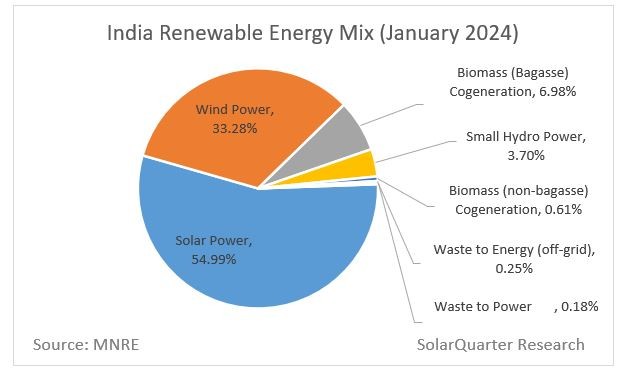
- 22 Jan 2025
Introduction
India's transition towards clean energy has accelerated, with 2024 witnessing record-breaking renewable energy (RE) installations and policy innovation. With a vision to achieve 500 GW of non-fossil fuel capacity by 2030 and net-zero emissions by 2070, India is shaping itself as a global leader in sustainable development.
What is Renewable Energy?
Renewable energy is derived from naturally replenishing sources like solar, wind, hydropower, and biomass. It plays a vital role in:
- Reducing dependence on fossil fuels.
- Lowering greenhouse gas emissions.
- Ensuring long-term energy security.
India’s RE Targets and Progress
Parameter Target/Status
2030 Target 500 GW of non-fossil fuel capacity
Net Zero by 2070
Current Status (Jan 2025) 217.62 GW of non-fossil fuel-based capacity
Short-term Goal 50% energy capacity from renewable sources
2024: Year of Renewable Milestones
Solar Energy
- 24.5 GW added in 2024 — a 2.8x increase over 2023.
- 18.5 GW utility-scale solar: Rajasthan, Gujarat, Tamil Nadu contributed 71%.
- Rooftop Solar:
- 4.59 GW added (↑53%)
- 7 lakh installations under PM Surya Ghar: Muft Bijli Yojana.
- Off-grid Solar:
- 1.48 GW added (↑182%), promoting rural energy access.
Wind Energy
- 3.4 GW added: Gujarat (1,250 MW), Karnataka (1,135 MW), Tamil Nadu (980 MW) = 98% of new capacity.
Hydropower & Others
- Existing hydropower plants modernized to improve efficiency.
Government Initiatives Driving Growth
Scheme/Initiative Purpose
PM Surya Ghar: Muft Bijli Yojana Rooftop solar subsidies for households
Green Energy Corridor (GEC) Transmission infra for RE-rich states
Hydrogen Energy Mission Promote green hydrogen production
National Smart Grid Mission (NSGM) Integration of variable RE sources into the grid
FAME Scheme Promote EV adoption, indirectly supporting RE usage
International Solar Alliance (ISA) Strengthen global cooperation in solar energy
Challenges in RE Expansion
- Land Acquisition: Resistance from locals, especially in solar park areas.
- Grid Stability: Intermittency of solar/wind leads to voltage and frequency issues.
- Storage Gaps: Lack of large-scale battery storage limits surplus utilization.
- E-Waste Concerns: Rising disposal of solar panels and batteries.
- Mineral Dependency: Import reliance on lithium, cobalt, etc.
- Regulatory Bottlenecks: Delay in approvals and lack of inter-state coordination.
Way Forward: Strategic Interventions
Technological Innovation
- Floating Solar Projects: Utilize reservoirs to save land and reduce evaporation.
- Decentralized Systems: Peer-to-peer trading via blockchain for energy democratization.
- Green Hydrogen: Use surplus RE for hydrogen fuel, develop hydrogen corridors.
Infrastructure & Manufacturing
- Renewable Energy SEZs: Promote local manufacturing and innovation.
- Smart Grid Development: Improve grid flexibility and real-time balancing.
Environmental Management
- Circular Economy for RE Waste: Design policies for solar panel and battery recycling.
- Urban Integration: Incentivize rooftop installations in urban centers.
Conclusion
India’s renewable energy revolution is at a crucial juncture. With 2024 setting a strong precedent through record installations and policy progress, the path to 2030 and beyond will require addressing infrastructural, financial, and regulatory challenges. A multi-pronged, inclusive, and technology-driven approach will help India lead the global clean energy transition.
Why Indian cities need Behavioral Change Officers
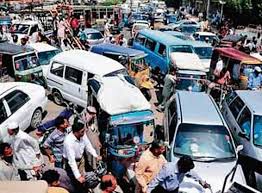
- 21 Jan 2025
Urban India at a Crossroads
India's urban population is projected to reach 40% by 2030, up from 30% in 2011. While this urban surge brings opportunities for economic and social progress, it also amplifies challenges such as:
- Infrastructure strain
- Environmental degradation
- Social inequality
- Climate impacts—including increased frequency of floods, heatwaves, and climate-driven migration
Traditionally, governments have relied on a combination of policy reforms, infrastructure investment, and technological advancements. However, a crucial component is often overlooked: behavioral change.
The Case for Behavioral Change in Urban Governance
Urban planning and service delivery frequently overlook how citizen and provider behavior shapes outcomes. Sustained, meaningful change requires more than just awareness campaigns—it demands behaviorally-informed governance. Here's why:
- Enhancing Service Delivery: Cities like Indore showcase how behavior change can revolutionize urban systems. Once struggling with waste management, Indore became India’s cleanest city through:
- Door-to-door campaigns
- Strict enforcement of segregation rules
- Viral initiatives like the ‘Kachra Gadi’ song to shift mindsets
- Driving Sustainability: In cities like Delhi, the odd-even vehicle rule led to a 30% reduction in traffic congestion by using simple default behavioral triggers. When people opt for public transport or energy conservation, it reduces emissions and eases city operations.
- Improving Public Safety: Behavioral strategies also improve law enforcement and community trust. For instance, Kerala’s ‘Janamaithri Suraksha’ program emphasizes empathetic policing, resulting in stronger police-citizen relations.
- Boosting Institutional Efficiency: Embedding behavioral insights can improve the efficiency of government schemes. The NITI Aayog’s Behavioral Insights Unit and initiatives in Uttar Pradesh and Bihar demonstrate success in using nudges to improve outcomes in areas like maternal health and welfare delivery.
Why Cities need Chief Behavioral Officers (CBOs)
To embed these insights systematically, Indian cities must institutionalize behavioral science through dedicated roles like Chief Behavioral Officers (CBOs) within Urban Local Bodies.
CBO Functions:
- Integrate behavioral strategies into urban planning
- Design evidence-backed nudges and campaigns
- Collaborate with stakeholders, municipal officers, and researchers
- Guide data-driven policy experimentation
Support Structure:
- A small team of behavioral fellows
- Annual Behavioral Plans aligned with city goals
- Investment in citizen engagement platforms
- Use of big data and surveys to uncover behavioral bottlenecks
Examples from global cities like New Orleans (via What Works Cities) show that CBOs can drive change quickly and cost-effectively.
Challenges to Behaviorally-Informed Urbanism
Despite its promise, this approach faces several roadblocks:
- Cultural inertia and resistance to change (e.g., reluctance in waste segregation)
- Lack of training in behavioral science among officials
- Resource constraints in smaller municipalities
- Fragmented coordination between departments (e.g., transport, sanitation)
Way Forward
To overcome these challenges, cities must:
- Institutionalize behavioral roles in governance structures
- Partner with behavioral scientists and think tanks
- Leverage technology (e.g., mobile apps for citizen feedback)
- Scale successful pilots (e.g., Indore’s waste model) across regions
This structured approach not only improves efficiency and citizen satisfaction, but also reduces the costs of service delivery, allowing long-term savings.
India-Middle East-Europe Economic Corridor (IMEC)
- 20 Jan 2025
Context:
- The India-Middle East-Europe Economic Corridor (IMEC), announced at the G20 Summit 2023 in New Delhi, is a transformative multi-modal connectivity initiative aiming to link India, the Middle East, and Europe through railways, ports, roads, energy pipelines, and digital infrastructure.
- Seen as a strategic counter to China’s Belt and Road Initiative (BRI), IMEC marks a significant step in reshaping global trade routes and enhancing economic cooperation across continents.
Structure and Components of IMEC
- Corridors:
- Eastern Corridor: Connects India to the Arabian Peninsula
- Northern Corridor: Links the Gulf to Europe
- Key Infrastructure:
- Rail and road networks
- Shipping routes from Indian ports (e.g., Mumbai, Mundra, Kandla, JNPT) to UAE and onwards via rail to Saudi Arabia, Jordan, and Israel (Haifa Port)
- Maritime link from Haifa to Piraeus Port in Greece, and further into Europe
- Electricity grids, green hydrogen pipelines, and high-speed data cables
- Participating Nations: India, US, Saudi Arabia, UAE, France, Germany, Italy, European Union
- Support Mechanism: US-led Partnership for Global Infrastructure and Investment (PGII)
Significance of IMEC
For India
- Enhanced Global Connectivity:
- Provides faster, cost-effective access to European markets
- Reduces dependence on the Suez Canal, a known chokepoint
- Economic Gains:
- Boosts the Make in India initiative through expanded market access
- Enhances maritime security and tourism opportunities in the Mediterranean
- Strategic Leverage:
- Strengthens ties with Middle East, US, and Europe
- Reinforces India’s image as a global strategic partner
- Energy Security and Green Growth:
- Facilitates the Green Grid Concept via power lines and hydrogen pipelines
- Aligns with India’s clean energy and decarbonisation goals
- Digital and Cyber Infrastructure:
- Supports data flow and communication resilience across the corridor
For the United States
- Strategic Counter to BRI:
- Offers democratic nations an alternative to China’s BRI
- Reinforces Transatlantic Unity:
- Addresses trust deficits post Ukraine war
- Reaffirms US commitment to European allies
- Energy and Supply Chain Security:
- Reduces reliance on adversarial energy routes
- Diversifies regional supply chains
- Geopolitical Stability:
- Encourages peaceful engagement among West Asian rivals
- Deters alignment with China-led blocks
- Job Creation and Economic Growth:
- Infrastructure investments boost local economies and employment
Strategic and Geopolitical Implications
- Acts as a balancing mechanism in global geopolitics against the influence of China’s BRI
- Built on diplomatic breakthroughs such as the Abraham Accords
- Promotes economic cooperation between traditional rivals (e.g., Israel, Saudi Arabia, UAE)
- Supports a rules-based international order centered on transparency, sustainability, and democratic values
Challenges to Implementation
- Geopolitical Instability: Conflicts such as Israel-Hamas, Iran-Saudi tensions, or political instability in West Asia can delay progress
- Infrastructure Bottlenecks:
- High capital requirement and complexity of cross-border integration
- Varying timelines and priorities among participating nations
- Competing Regional Interests:
- Exclusion of key players like Turkey, Iran, and China may trigger pushback
- Turkey’s rivalry with Greece and Israel may create diplomatic hurdles
Security Concerns: Risk of terrorism, piracy, and cyber threats in unstable regions
Israel-Hamas Ceasefire

- 19 Jan 2025
In News:
After 15 months of war triggered by Hamas' October 2023 attack on Israel, a ceasefire agreement has been brokered by Qatar, Egypt, and the US, marking a fragile but significant pause in one of the most destructive phases of the Israel-Palestine conflict.
Key Features of the Ceasefire Agreement
The agreement is based on a three-phase framework proposed by US President Joe Biden in June 2024 and endorsed by the UN Security Council:
Phase I (42 days)
- Complete ceasefire and withdrawal of Israeli forces from all populated areas in Gaza.
- Release of 33 Israeli hostages (women, elderly, injured) by Hamas.
- Release of 900–1,650 Palestinian prisoners, including minors and those detained since October 7, 2023.
- Daily entry of 600 humanitarian aid trucks into Gaza.
- Partial Israeli withdrawal from key corridors like Netzarim (splitting Gaza) and parts of the Philadelphi Corridor (Gaza-Egypt border).
Phase II
- Release of remaining hostages, primarily male soldiers.
- Complete Israeli military withdrawal from Gaza.
- Details to be negotiated during Phase I; no written guarantees for its execution.
Phase III
- Return of the remains of deceased hostages.
- Initiation of a multi-year reconstruction plan for Gaza under international supervision.
Challenges to Implementation
Fragile Political Consensus in Israel
- Far-right ministers (e.g., Itamar Ben-Gvir) oppose the deal, threatening to quit the government.
- Prime Minister Netanyahu faces pressure from both hawks demanding a full military victory and moderates seeking peace.
Hamas' Demands
- Seeks permanent ceasefire and complete Israeli withdrawal, making it unwilling to release all hostages without guarantees.
- Israel, in contrast, insists on neutralizing Hamas militarily.
Unclear Future Governance of Gaza
- Israel rejects both Hamas and the Palestinian Authority (PA) as future administrators.
- Global consensus supports Palestinian-led governance, but viable alternatives remain elusive.
Wider Geopolitical Impact
Reshaping West Asia
- Conflict escalated tensions with Hezbollah (Lebanon) and drew Israel into direct conflict with Iran.
- Iran’s influence weakened due to losses in Hezbollah and Syria.
- Assad regime in Syria collapsed, altering regional power dynamics.
Diplomatic Repercussions for Israel
- Despite military dominance, Israel faces global condemnation over civilian casualties.
- PM Netanyahu is under scrutiny at the ICC (war crimes) and ICJ (genocide allegations).
- Israel is now diplomatically isolated, particularly after the humanitarian toll in Gaza.
Humanitarian Crisis in Gaza
- Over 64,000 Palestinians killed (The Lancet, 2024), including large numbers of civilians.
- Massive destruction of infrastructure—schools, hospitals, homes—rendering Gaza nearly uninhabitable.
- Reconstruction hinges on sustained peace and international aid.
Conclusion
The ceasefire presents a rare opportunity for de-escalation in a deeply entrenched conflict. However, distrust between parties, domestic political constraints, and regional rivalries pose significant risks to its sustainability. A durable peace can only emerge through inclusive political dialogue, humanitarian prioritization, and movement toward a two-state solution.
River Interlinking in India
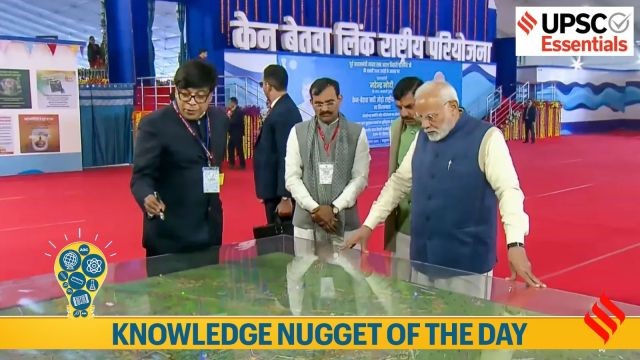
- 18 Jan 2025
Context:
India, with 17% of the world’s population but only 4% of its freshwater resources, faces significant water distribution challenges. The ambitious river interlinking project aims to mitigate regional water imbalances by transferring water from surplus areas to water-deficient regions, addressing irrigation, drinking water supply, flood control, and overall development.
Background and Evolution
The idea of interlinking rivers dates back to 1858 when British engineer Captain Arthur Cotton proposed linking rivers for inland navigation. Post-independence, Dr. K.L. Rao (1972) suggested the ‘Ganga-Cauvery Link Canal,’ followed by Captain Dinshaw J. Dastur’s ‘National Garland Canal’ proposal in 1977. However, these were deemed infeasible. In 1980, the Ministry of Water Resources formulated the National Perspective Plan (NPP), identifying 30 river link projects—14 under the Himalayan component and 16 under the Peninsular component.
The National Water Development Agency (NWDA) was established in 1982 to study and implement these projects. The Supreme Court, in response to a PIL in 2002, directed the government to expedite the completion of interlinking projects.
Ken-Betwa Link Project (KBLP)
The first project under the NPP, the Ken-Betwa Link Project (KBLP), was inaugurated on December 25, 2024. It aims to provide irrigation to Bundelkhand, one of India’s most drought-prone regions, by transferring surplus water from the Ken River in Madhya Pradesh to the Betwa River in Uttar Pradesh. Covering 10.62 lakh hectares of land (8.11 lakh ha in MP and 2.51 lakh ha in UP), the project will supply drinking water to 62 lakh people and generate 103 MW of hydropower along with 27 MW of solar power. However, environmental concerns persist as it passes through the Panna Tiger Reserve.
Significance of River Interlinking
- Water Redistribution: The scheme will transfer about 200 billion cubic meters (BCM) of water annually to water-scarce regions, ensuring equitable distribution.
- Agricultural Benefits: It will irrigate approximately 34 million hectares of farmland, enhancing food security and increasing agricultural productivity.
- Hydropower Generation: An estimated 34,000 MW of hydropower will be generated, supporting renewable energy expansion.
- Flood and Drought Mitigation: Excess water will be stored in reservoirs, reducing flood risks while ensuring availability during droughts.
- Economic Growth: Improved water availability will boost industries, generate employment, and aid in rural development.
Environmental and Social Concerns
- Ecological Disruptions: Altering river morphology can impact sediment transport, water quality, and aquatic ecosystems.
- Biodiversity Loss: Dams and canals may disrupt fish migration patterns and submerge forests, leading to biodiversity depletion.
- Climate Impact: Water transfer may affect regional climate attributes, altering temperature, precipitation, and humidity levels.
- Displacement and Social Issues: Large-scale projects often lead to displacement of communities, causing resettlement challenges and conflicts over compensation.
- Economic Viability: High project costs and potential delays raise concerns about financial feasibility compared to alternative solutions like rainwater harvesting and local water conservation.
Conclusion
While river interlinking presents a potential solution to India’s water crisis, it must be carefully assessed against environmental and social impacts. Sustainable water management strategies, such as efficient irrigation techniques and localized conservation methods, should complement large-scale projects to ensure a balanced approach to water security and development.
Satellite Docking Experiment (SpaDeX)
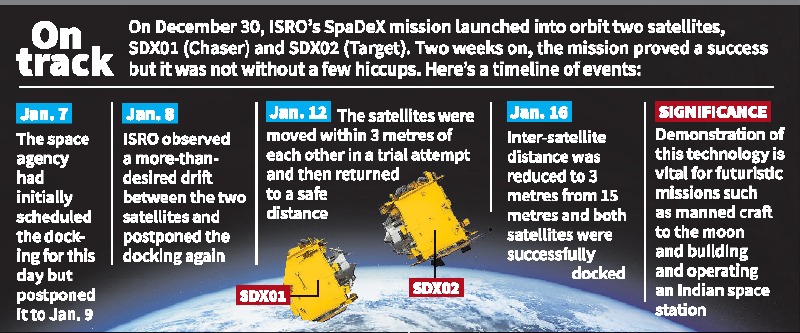
- 17 Jan 2025
In News:
The Indian Space Research Organisation (ISRO) achieved a historic milestone by successfully executing a satellite docking experiment, making India the fourth country after the United States, Russia, and China to accomplish this feat. This advancement represents a significant leap in India's space capabilities, positioning the nation at the forefront of space exploration and in-orbit servicing.
Key Highlights:
- The Space Docking Experiment (SpaDeX) is a critical technological demonstration by ISRO aimed at developing autonomous docking and undocking capabilities in space.
- The mission involves two satellites, SDX01 (Chaser) and SDX02 (Target), which were launched aboard PSLV C60 on December 30, 2024.
- The docking maneuver was overseen by the Mission Operations Complex (MOX) at the ISRO Telemetry, Tracking, and Command Network (ISTRAC) and was successfully completed in the early hours of January 18, 2025.
Key Steps in the Docking Process:
- Manoeuvre from 15m to 3m hold point.
- Precision docking initiation, leading to spacecraft capture.
- Retraction and rigidization for stability.
- Successful control of the docked satellites as a single object.
Significance of the Mission
- Technological Advancement: The docking of two spacecraft in orbit is a crucial capability that paves the way for:
- Autonomous spacecraft operations
- Refueling and maintenance of satellites
- Space station development
- Lunar and interplanetary missions
Future Applications
- Manned Missions: Enables India to develop technology for manned lunar missions and future space station operations.
- Satellite Servicing: Allows repair, maintenance, and extension of satellite lifespan, reducing costs and space debris.
- Sample Return Missions: Essential for lunar and planetary sample retrieval, crucial for deep-space exploration.
Challenges and Overcoming Setbacks
The SpaDeX docking was initially scheduled for January 7, 2025, but was postponed due to the need for further ground validation and an unexpected drift between the satellites. The issue was later resolved, and the docking was executed with precision.
The Road Ahead
Undocking and Power Transfer Demonstration
- ISRO will follow up with power transfer checks between the docked satellites.
- The satellites will later undock and operate separately for the remaining mission duration of up to two years.
Expanding Space Capabilities
- The successful execution of SpaDeX aligns with India’s plans for an independent space station by the 2030s.
- Strengthens India’s position in international space collaborations and commercial space services.
Conclusion
The SpaDeX mission represents a landmark achievement for India’s space program, placing it among the elite nations capable of satellite docking. This breakthrough will serve as a foundation for India’s ambitious future missions, including deep-space exploration, human spaceflight, and interplanetary research. As ISRO continues to develop advanced space technologies, India is set to play a crucial role in the future of global space exploration.
Digital Governance in India

- 16 Jan 2025
In News:
India is making significant strides toward digital governance, an initiative aimed at enhancing both citizen services and the capabilities of government employees. This transition to a digitally-driven framework is designed to improve the efficiency, transparency, and accountability of government operations, positioning India as a global leader in modern governance practices.
What is Digital Governance?
Digital governance refers to the application of technology to enhance the functioning of government processes. By integrating digital tools and platforms, it aims to streamline administrative operations, reduce inefficiencies, and improve public service delivery. This approach also extends to ensuring greater transparency and accountability in government dealings.
Key Initiatives in Digital Governance
India has launched several critical initiatives to modernize governance through digital means. Some of the key programs include:
- iGOT Karmayogi Platform: The iGOT Karmayogi platform is a government initiative to provide online training to public employees. It aims to enhance public administration skills, foster expertise in data analytics, and equip employees with the necessary tools in digital technologies. This initiative aims to prepare government personnel to handle the challenges of a digitally evolving governance landscape.
- e-Office Initiative: The e-Office program is designed to reduce paper-based work by digitizing workflows within government departments. This initiative facilitates real-time communication among offices and ensures more efficient and transparent management of tasks. It also helps streamline decision-making processes and improves the speed of governance operations.
- Government e-Marketplace (GeM): The Government e-Marketplace (GeM) is an online platform developed to optimize procurement processes. It allows government agencies to procure goods and services efficiently, transparently, and with accountability. This platform has contributed to reducing corruption and ensuring that government purchases represent the best value for public money.
- Cybersecurity Training for Employees: As digital operations increase, ensuring the safety of sensitive data is paramount. The cybersecurity training program for government employees is designed to enhance their ability to recognize and respond to potential cyber threats. This initiative ensures data protection, safe online practices, and cyber resilience across digital governance platforms.
Challenges in Implementing Digital Governance
Despite its benefits, India faces several challenges in the successful implementation of digital governance. These obstacles must be addressed to unlock the full potential of technology-driven governance.
- Resistance to Technological Change: One of the key barriers to digital transformation in government is the resistance among employees to adopt new technologies. Many government officials remain accustomed to traditional, paper-based processes and are reluctant to transition to digital systems due to concerns about complexity and job security.
- Digital Divide in Rural Areas: While urban regions in India have better access to high-speed internet and digital infrastructure, many rural areas face significant digital divide challenges. Limited access to technology hampers the successful implementation of digital governance in these regions, restricting equitable service delivery across the country.
- Cybersecurity Risks: The rise of digital operations in governance increases the risk of cyberattacks and data breaches. With government data being digitized, the threat of cybercrimes becomes more pronounced, making it critical to implement robust cybersecurity measures and data protection strategies to safeguard sensitive information.
- Lack of Incentives for Training Outcomes: Although government employees are encouraged to take part in training programs such as iGOT Karmayogi, the absence of clear incentives to complete these programs can undermine their effectiveness. Establishing tangible rewards or career progression linked to the successful completion of training would encourage employees to fully engage in capacity-building initiatives.
Solutions to Overcome Challenges
To ensure the success of digital governance, several strategies must be put in place to address the challenges identified.
- Foster Innovation-Friendly Environments: Promoting an innovation-friendly culture within government offices can help reduce resistance to new technologies. Encouraging employees to engage with digital tools, offering regular training, and providing ongoing support will facilitate a smoother transition to a technology-driven governance system.
- Invest in Digital Infrastructure for Rural Areas: Addressing the digital divide requires significant investment in digital infrastructure in rural and remote areas. Ensuring that these regions have reliable internet access and the necessary technological resources will empower citizens across India to benefit from digital governance.
- Continuous Capacity-Building Programs: Establishing continuous training programs for government employees will ensure that they remain up-to-date with the latest technological trends. Regular updates to training content will help employees stay prepared to handle emerging challenges in digital governance.
- Strengthen Cybersecurity Protocols: To mitigate cybersecurity risks, it is essential to implement stringent cybersecurity measures across all levels of government operations. This includes regular cybersecurity awareness programs, proactive threat management systems, and rigorous data protection protocols to safeguard both government data and citizens’ personal information.
Conclusion
India’s shift towards digital governance represents a significant step toward modernizing administrative systems, enhancing transparency, and improving service delivery to citizens. However, challenges such as resistance to change, the digital divide, cybersecurity risks, and the lack of clear incentives for training must be addressed. By investing in digital infrastructure, offering continuous training programs, and reinforcing cybersecurity measures, India can create an effective and secure framework for digital governance that benefits both its citizens and the government workforce.
India’s Startup Revolution

- 15 Jan 2025
Context
India has solidified its position as one of the most dynamic startup ecosystems globally, emerging as a hub for innovation, entrepreneurship, and technological progress. However, realizing its ambition of becoming the top startup ecosystem requires addressing critical challenges and leveraging available opportunities.
Current Landscape of Indian Startups
Growth and Innovation
India ranks as the third-largest startup ecosystem in the world, following the U.S. and China. As of January 15, 2025, over 1.59 lakh startups have been officially recognized by DPIIT, with more than 120 attaining unicorn status (valuation exceeding $1 billion).
Investment Trends
Despite economic fluctuations, India's startups continue to attract significant investments. In 2022, venture capitalists infused $25 billion into the ecosystem, reaffirming India’s position as a preferred destination for global investors. Although there was a slowdown in 2023, domains like Software as a Service (SaaS) and climate tech continue to secure substantial funding.
Government Support
India’s startup-friendly policies, including Startup India, Digital India, and Atmanirbhar Bharat, have created an enabling environment. Notable initiatives include:
- Tax incentives, faster patent approvals, and regulatory relaxations.
- The launch of a ?10,000 crore Fund of Funds for Startups (FFS) in 2023 to improve capital accessibility.
- The Bharat Startup Knowledge Access Registry (BHASKAR) to streamline collaboration among startups and investors.
Regional Growth
- Tier II and III Expansion: Nearly 50% of startups are now based in emerging hubs such as Indore, Jaipur, and Ahmedabad.
- Tamil Nadu: The state boasts a $28 billion startup ecosystem, growing at 23%. Chennai alone houses around 5,000 startups, significantly contributing to employment generation.
- Kerala: With a $1.7 billion startup ecosystem, Kerala exhibits a compound annual growth rate of 254%, emphasizing cost-effective tech talent hiring.
Key Challenges Faced by Startups
1. Funding Constraints
The global economic downturn, coupled with rising interest rates, has limited venture capital inflows, resulting in layoffs and operational cutbacks.
2. Regulatory and Compliance Barriers
Despite government support, startups grapple with complex tax structures, evolving data protection laws, and stringent compliance requirements, including ESOP taxation policies.
3. Scaling and Market Adaptability
Many startups struggle with operational inefficiencies, limited market penetration, and inadequate infrastructure, hampering growth potential.
4. High Failure Rate
Approximately 90% of Indian startups fail within five years due to poor product-market fit, lack of financial planning, and insufficient adaptation to market needs.
5. Talent Shortages
India faces stiff competition in acquiring skilled professionals in areas like AI, cybersecurity, and machine learning, making retention increasingly difficult amid economic uncertainties.
Strategic Measures to Strengthen India’s Startup Ecosystem
1. Enhancing Policy Frameworks
- Simplified Regulations: Streamline startup registration, funding approvals, and international business operations.
- IP Protection: Strengthen intellectual property laws to boost R&D investment.
- Sector-Specific Initiatives: Develop targeted policies for AI, deep tech, healthcare, and green technologies.
2. Expanding Funding Access
- Encouraging Domestic Investment: Leverage pension and sovereign wealth funds to invest in startups.
- Public-Private Partnerships: Foster large-scale government-industry collaboration to finance emerging ventures.
- Decentralized Funding: Expand angel investor networks and micro-investment opportunities, particularly in Tier II and III cities.
3. Building Robust Infrastructure
- Tech Parks and Incubation Centers: Establish state-of-the-art facilities with mentorship programs.
- Improved Digital Connectivity: Ensure high-speed internet access in underserved regions.
- Enhanced Logistics and Supply Chains: Strengthen infrastructure to support startup scalability.
4. Developing a Skilled Workforce
- STEM and Entrepreneurial Education: Introduce curriculum enhancements in technical and business disciplines.
- Upskilling Programs: Collaborate with industry leaders to train professionals in high-demand skills.
- Diversity and Inclusion: Promote initiatives encouraging women and marginalized communities in entrepreneurship.
5. Fostering Innovation and Risk-Taking
- Strengthened R&D Funding: Increase allocations to universities and private research sectors.
- Encouraging Entrepreneurship: Reduce societal stigma surrounding startup failures to promote risk-taking.
- Leveraging Domestic Challenges: Address local issues like climate change and urbanization through innovation.
6. Expanding Global Reach
- International Collaborations: Partner with foreign accelerators and governments.
- Ease of Cross-Border Trade: Simplify export and import regulations for startups.
- Engaging the Indian Diaspora: Encourage successful overseas entrepreneurs to mentor and invest in Indian startups.
7. Advancing Sustainability Goals
- Green Tech Promotion: Support startups focusing on renewable energy and circular economy initiatives.
- Eco-Friendly Incentives: Offer financial support to ventures aligning with sustainability targets.
- Inclusive Growth Strategies: Expand agritech, edtech, and health-tech startups in rural areas, supporting platforms like the Women Entrepreneurship Platform (WEP) by NITI Aayog.
Building a Resilient Digital Economy
To fortify India's digital economy, startups should leverage existing infrastructure like UPI and Aadhaar while capitalizing on emerging technologies such as AI, 5G, and blockchain. A robust cybersecurity framework and data protection policies will be essential to ensure investor confidence.
Genome India Project

- 14 Jan 2025
In News:
The Genome India Project is an ambitious national initiative aimed at decoding the genetic diversity of India’s population. Launched in January 2020 by the Department of Biotechnology (DBT), the project seeks to create a comprehensive map of India’s genetic variations, offering insights that can revolutionize public health, medicine, and our understanding of human genetics.
What is Genome Sequencing?
Genome sequencing is the process of determining the complete DNA sequence of an organism’s genome. The human genome, composed of about 3 billion base pairs of DNA, contains all the genetic instructions necessary for the growth, development, and functioning of the human body. The process involves extracting DNA from a sample (often blood), breaking it into smaller fragments, and using a sequencer to decode these fragments. The data is then reassembled to reconstruct the full genome.
Key Aims and Objectives
The Genome India Project aims to address several crucial scientific and healthcare challenges:
- Create an Exhaustive Catalog of Genetic Variations: This includes common, low-frequency, rare, and structural variations (such as Single Nucleotide Polymorphisms or SNPs).
- Establish a Reference Haplotype Structure: This reference panel will be used for imputing missing genetic variations in future genetic studies.
- Design Affordable Genome-wide Arrays: These arrays will be useful for research and diagnostics at a lower cost, making genetic analysis accessible.
- Create a Biobank for Future Research: The collected DNA and plasma will be preserved for future studies to facilitate ongoing genetic research.
Genome India Project: Phase 1 and Key Findings
The project’s Phase 1 focused on sequencing the genomes of 10,074 individuals from 99 ethnic groups across India. This initiative provides a critical baseline for studying the country’s genetic diversity. Some of the key findings include:
- 459 plant species have been identified as part of genetic diversity studies.
- 135 million genetic variations have been uncovered, including 7 million that are unique to India, not found in global databases.
- The project has revealed several genetic risks specific to Indian populations, such as the MYBPC3 mutation (linked to cardiac arrest) and the LAMB3 mutation (associated with a lethal skin condition), which are not commonly seen in global datasets.
This database will serve as a vital resource for researchers, contributing to the development of precision medicine, better disease diagnosis, and more personalized treatments.
Second Phase: Expanding the Scope
The second phase of the Genome India Project will focus on sequencing the genomes of individuals suffering from specific diseases. This will enable researchers to:
- Compare the genomes of healthy individuals with those having diseases, helping identify genetic mutations responsible for conditions like cancer, diabetes, and neurodegenerative diseases.
- Investigate rare diseases specific to Indian populations and develop therapies tailored to these conditions.
By sequencing the genomes of individuals with various conditions, the project aims to pinpoint genetic factors that contribute to the pre-disposition or causation of diseases.
Data Sharing and Security
To ensure data security and privacy, the genetic information will be made available only through managed access. Researchers interested in using the data will need to submit a proposal and collaborate with the Department of Biotechnology. The data will be stored securely at the Indian Biological Data Centre (IBDC) in Faridabad, Haryana, and anonymized to maintain confidentiality.
Why Does India Need Its Own Genetic Database?
India is home to a highly diverse population, with over 4,600 distinct ethnic groups and varying genetic backgrounds. The country’s genetic diversity, shaped by its geographical, cultural, and historical context, cannot be fully understood through datasets derived from other countries. The Genome India Project helps:
- Identify Genetic Risk Factors: For various diseases, paving the way for developing targeted diagnostic tools and therapies.
- Uncover Unique Variants: Some genetic mutations found in India, such as the Vaishya community’s resistance to anaesthetics, are absent in global databases.
- Address Population-specific Health Issues: Genetic mapping enables the identification of prevalent diseases and health conditions specific to Indian populations.
Global Context and Comparison
India’s genome sequencing effort is part of a larger global movement in genomics:
- Human Genome Project (2003): The first international effort to decode the human genome.
- 1,000 Genome Project (2012): Published 1,092 human genome sequences.
- UK 100,000 Genome Project (2018): Sequenced 100,000 genomes for health research.
- European Genome Project: Aims to sequence over 1 million genomes across 24 countries.
The Genome India Project fills a crucial gap by focusing on the genetic diversity of Indian populations, which differs significantly from the genetic profiles studied in Western or European genomes.
Applications of Genome India Project
The Genome India Project has the potential to impact multiple areas:
- Advancements in Medicine: Understanding genetic variations can lead to the development of personalized medicine, where treatments are tailored to individual genetic profiles.
- Genetic and Infectious Disease Control: The project helps identify genetic resistance to diseases, and aids in understanding how certain populations may respond differently to drugs or vaccines.
- Public Health Policies: Data from the project can inform health policies, especially in tackling diseases prevalent in specific regions or communities.
- International Research Collaboration: The project aims to foster collaboration with global research communities, enhancing India’s presence in the field of genomics.
Conclusion:
The Genome India Project is a landmark initiative for India’s scientific community, enabling better understanding of the country’s genetic diversity and paving the way for breakthroughs in medicine, healthcare, and disease prevention. The ability to analyze genetic variations on such a large scale provides immense opportunities for precision medicine and personalized treatments.
Rat-hole mining
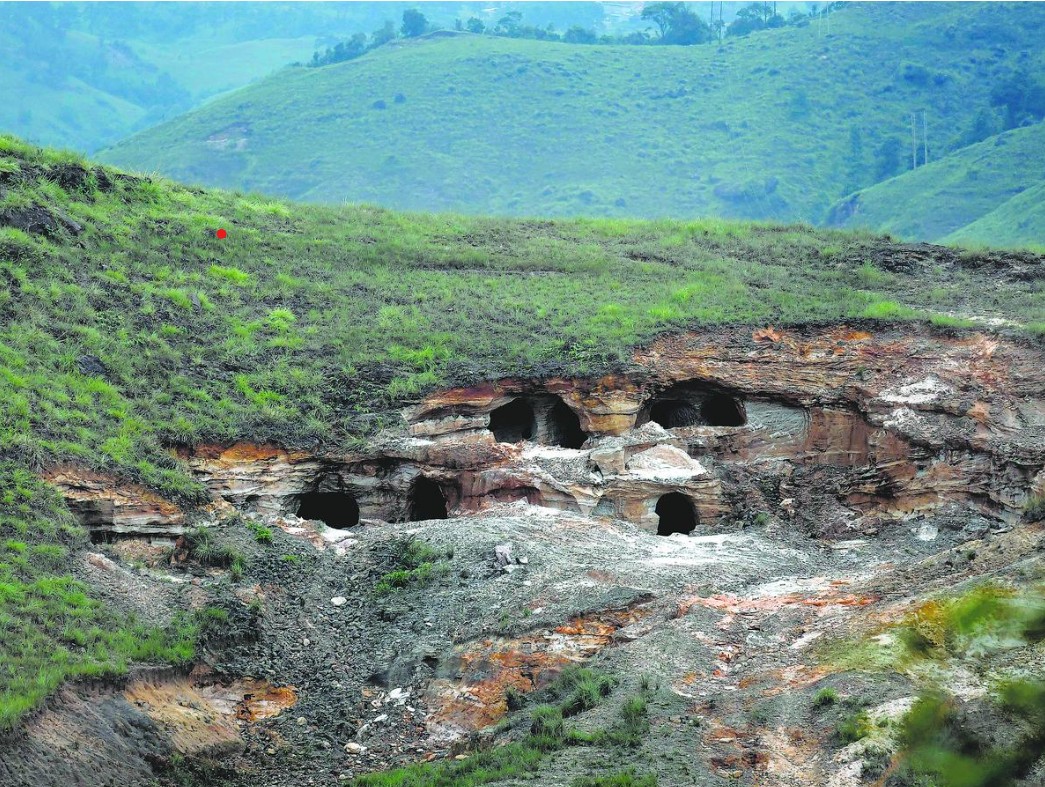
- 13 Jan 2025
In News:
In Dima Hasao district of Assam, at least nine workers aged between 26 and 57 were trapped in a coal “rat-hole” mine after it was flooded with water. Three miners trapped in a flooded coal mine were confirmed dead, while six remained stuck. Later an Indian Navy team, including deep-sea divers, arrived at the site, where the water level inside the pit is 200 feet deep.
Key Takeaways:
- Rat-hole mining is a method of extracting coal from narrow, horizontal seams, prevalent in Meghalaya. The term “rat hole” refers to the narrow pits dug into the ground, typically just large enough for one person to descend and extract coal.
- Once the pits are dug, miners descend using ropes or bamboo ladders to reach the coal seams. The coal is then manually extracted using primitive tools such as pickaxes, shovels, and baskets.
- Types of Rat-hole mining:
- Side-cutting mining: In the side-cutting procedure, narrow tunnels are dug on the hill slopes and workers go inside until they find the coal seam. The coal seam in the hills of Meghalaya is very thin, less than 2 m in most cases.
- Box-cutting mining: In the other type of rat-hole mining, called box-cutting, a rectangular opening is made, varying from 10 to 100 sqm, and through that a vertical pit is dug, 100 to 400 feet deep. Once the coal seam is found, rat-hole-sized tunnels are dug horizontally through which workers can extract the coal.
- Concerns associated with Rat-hole mining: Rat-hole mining poses significant environmental and safety hazards. This method of mining has faced severe criticism due to its hazardous working conditions, and numerous accidents leading to injuries and fatalities.
- The mines are typically unregulated, lacking safety measures such as proper ventilation, structural support, or safety gear for the workers. Additionally, the mining process can cause land degradation, deforestation, and water pollution. Despite attempts by authorities to regulate or ban such practices, they often persist due to economic factors and the absence of viable alternative livelihoods for the local population.
- Notably, the National Green Tribunal (NGT) banned Rat-hole mining in 2014, and retained the ban in 2015, on grounds of it being unscientific and unsafe for workers. The order was in connection with Meghalaya, where this remained a prevalent procedure for coal mining. The state government then appealed the order in the Supreme Court.
Role of Rat-Hole Mining in Uttarkashi Tunnel Rescue
- The rat-hole mining practice, banned for being unsafe, helped in the rescue operation of 41 workers trapped in the collapsed Silkyara-Barkot tunnel in Uttarakhand in 2023.
- Rat-hole miners were called in after the auger machine that was drilling through the debris broke. Rescuers then tried cutting through the blade stuck inside the rescue pipes and removing it piece by piece. As large metal pieces hindered the machine drilling, the rescuers went ahead with rat-hole mining.
- It was a test of grit and perseverance – for men on both sides of the 57 metres of debris – as the rescue operation suffered one setback after another. In the end, it was miners who dug through the last 12 metres and reached the trapped men.
Selection Process for Chief Election Commissioner (CEC)

- 12 Jan 2025
In News:
The Chief Election Commissioner and Other Election Commissioners (Appointment, Conditions of Service and Term of Office) Act, 2023 represents a significant shift in the process of selecting the Chief Election Commissioner (CEC) and other Election Commissioners (ECs) in India. Traditionally, the senior-most Election Commissioner automatically ascended to the position of CEC. However, the new law introduced in December 2023 widens the scope for selection, allowing for a more transparent process with an expanded pool of candidates.
Key Features of the Act:
- Election Commission Structure: The Election Commission of India is constituted by the Chief Election Commissioner (CEC) and two other Election Commissioners (ECs). The President of India appoints these members, with the number of ECs fixed periodically.
- Appointment Process: The Act mandates that the CEC and ECs are appointed by the President based on recommendations from a Selection Committee. This committee comprises:
- The Prime Minister (Chairperson),
- The Leader of the Opposition in the Lok Sabha (or leader of the largest opposition party),
- A Union Cabinet Minister appointed by the Prime Minister.
- Search Committee: A Search Committee, chaired by the Minister of Law and Justice, prepares a panel of five candidates. The Selection Committee may choose from this panel or opt for someone outside of it.
- Eligibility Criteria:
- Candidates must have integrity and experience in election management.
- They should be or have been Secretary-level officers or equivalent.
- Term and Reappointment:
- The term of CEC and ECs is six years or until they turn 65 years.
- They cannot be re-appointed after their term.
- Salary and Pension: The salary, allowances, and conditions of service of CEC and ECs are equivalent to those of a Cabinet Secretary.
- Removal Process:
- The CEC can be removed in the same manner as a Supreme Court Judge.
- ECs can be removed only on the recommendation of the CEC.
Departure from Tradition:
Traditionally, the next CEC was the senior-most Election Commissioner. However, the new law opens the process, allowing the Search Committee to consider candidates outside the current pool of Election Commissioners. This widens the net and may lead to a more transparent and inclusive selection.
Concerns and Criticisms: While the Act aims to improve the selection process, it has faced scrutiny and concerns, particularly about the independence of the Election Commission:
- Government Influence: The inclusion of the Leader of Opposition in the Selection Committee is a positive step, but critics argue that the final decision may still be influenced by the government. The government’s dominance in the Selection Committee could potentially affect the neutrality of the Commission.
- Exclusion of the Chief Justice of India (CJI): The Supreme Court's 2023 ruling had recommended including the CJI in the committee, but the new Act excludes the CJI. This has raised concerns about the balance of power and the credibility of the Election Commission.
- Risk of Partisanship: Former CEC O.P. Rawat expressed concerns that political changes might influence decisions, leading to a compromised credibility of the Election Commission.
Legal Challenges: Petitions challenging the exclusion of the CJI from the Selection Committee are currently pending before the Supreme Court, which is expected to address them in February 2025.
Historical Context and Legal Backdrop:
- Article 324 of the Indian Constitution provides for the appointment of CEC and ECs by the President, but this is subject to laws passed by Parliament.
- In 2023, the Supreme Court intervened in response to the growing concerns over the executive's unilateral control over these appointments. The Court's ruling in the Anoop Baranwal v. Union of India case led to the formation of a committee comprising the Prime Minister, Leader of Opposition, and CJI until Parliament could enact a law. This resulted in the Chief Election Commissioner and Other Election Commissioners Act, 2023, which was aligned with the Court's directions.
Implications and Way Forward:
- Potential Government Influence: While the law aims to reduce executive control, the dominant role of the Prime Minister and the Leader of the Opposition could still allow the government to influence appointments, especially in contentious times.
- Suggestions for Reform: The Law Commission had recommended a broader selection committee, including the CJI, to ensure a balanced and impartial selection process. The National Commission to Review the Working of the Constitution (NCRWC) also suggested a committee comprising key political figures, including the Leader of Opposition in the Rajya Sabha and the Speaker of Lok Sabha.
- Integrity of the Election Commission: The credibility and impartiality of the Election Commission are vital for ensuring free and fair elections. It is crucial to ensure that the appointment process not only appears fair but is also free from political interference.
Conclusion:
The Chief Election Commissioner and Other Election Commissioners (Appointment, Conditions of Service and Term of Office) Act, 2023 introduces a reformed approach to the selection of the Election Commission members. While the law aims for greater transparency, it also raises concerns regarding government influence and independence. The Supreme Court’s review of the exclusion of the CJI from the Selection Committee will be pivotal in determining the future trajectory of the Election Commission’s appointment process. The evolving legal and institutional dynamics will play a significant role in shaping the electoral reforms in India.
Unified District Information System for Education Plus (UDISE+) Report
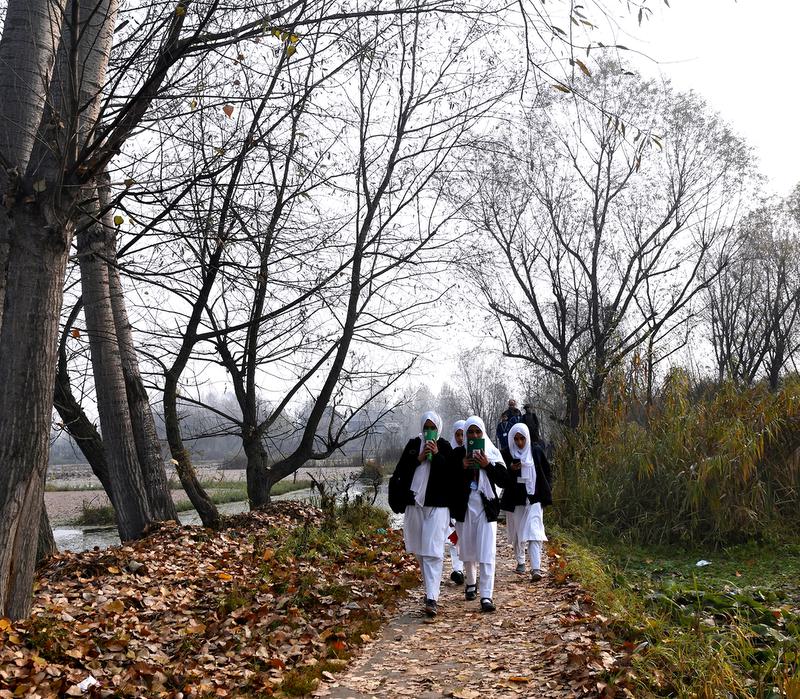
- 10 Jan 2025
In News:
The Unified District Information System for Education Plus (UDISE+) report for 2023-24 reveals a significant decline in school enrolment across India, highlighting critical challenges in the education sector. The total enrolment in grades 1-12 fell by over 1.55 crore students, from 26.36 crore (2018-2022 average) to 24.8 crore in 2023-24. This represents a 6% drop, with the biggest declines occurring in government schools.
Key Findings:
- Enrolment Decline:
- In 2023-24, enrolment decreased from 25.17 crore in 2022-23 to 24.8 crore.
- The drop was not only in government schools (5.59%) but also in private schools (3.67%).
- States like Bihar, Uttar Pradesh, and Maharashtra saw the largest decreases.
- The decline in enrolment is despite an increase in the number of schools, from 14.66 lakh in 2022 to 14.72 lakh in 2023.
- Methodology Change:
- A significant change in the data collection methodology occurred in 2022-23, including linking enrolment to Aadhaar numbers, aimed at reducing data duplication.
- While this has improved data accuracy, it has also led to the removal of inflated figures, explaining part of the enrolment drop.
- Despite these changes, there has been a notable decline of 37 lakh students from 2022-23 to 2023-24, which remains unexplained in the report.
- Gender and Age Trends:
- Boys’ enrolment declined by 6.04%, and girls’ by 5.76%, reflecting a uniform drop across gender groups.
- The dropout rates increase as students progress through school, with the highest dropout at the secondary level.
- Infrastructure and Facilities:
- While most schools have basic facilities like electricity and gender-specific toilets, advanced infrastructure like functional computers (57%) and internet access (53%) is lacking in nearly half of schools.
- This technological gap exacerbates regional disparities and affects educational quality, particularly in rural areas.
- State-Specific Impact:
- Jammu and Kashmir, Assam, Uttar Pradesh, and Madhya Pradesh saw the highest reductions in the number of schools.
- Many school closures or mergers have led to increased distances for students, causing further dropouts during re-admission processes.
Socio-Economic Barriers:
- Economic hardships, migration, and inadequate facilities contribute to the enrolment decline.
- Low-income families and backward regions struggle to prioritize education, further affecting enrolment and retention.
Government Initiatives:
- Initiatives like the National Education Policy (NEP) 2020, Sarva Shiksha Abhiyan, and Right to Education Act (RTE) have made strides in primary education but face challenges in secondary education.
- Education spending has hovered around 4-4.6% of GDP, which is insufficient to meet the needs of the education system.
Moving Forward:
- Targeted Interventions: Focus on expanding vocational training, incentivizing school attendance, and improving digital infrastructure in schools.
- Address Regional Disparities: Conduct audits to address school shortages in densely populated areas and consolidate underutilized urban schools.
- Enhancing Teacher Quality: Invest in teacher training and encourage innovative teaching methods.
- Community Engagement: Promote local participation in school management to address specific educational needs.
Conclusion:
The UDISE+ 2023-24 report underscores the need for urgent reforms in India's education system, focusing on increasing enrolment, reducing dropout rates, and ensuring equitable access to quality education. By addressing these challenges with targeted policies, India can move closer to achieving its educational goals.
Why Farmers Deserve Price Security
- 11 Jan 2025
Introduction:
The future of Indian agriculture is at a crossroads. With the shrinking of the agricultural workforce and the diversion of fertile farmlands for urbanization, ensuring the sustainability of farming is a strategic imperative. Among the various support mechanisms for farmers, the Minimum Support Price (MSP) remains a central point of debate. Should there be a legal guarantee for MSP? This question has gained prominence, especially with the rising challenges in agriculture, from unpredictable climate patterns to volatile market prices.
The Decline of Agriculture and Its Impact
India’s agricultural sector faces a dual crisis: loss of both land and human resources. Prime agricultural lands across river basins, such as the Ganga-Yamuna Doab or the Krishna-Godavari delta, are being repurposed for real estate, infrastructure, and industrial projects. Additionally, the number of "serious farmers" – those deriving at least half of their income from agriculture – is dwindling. The number of operational holdings may be 146.5 million, but only a small fraction of these farmers remains committed to agriculture.
This decline threatens the future of India’s food security, as the country will need to feed a population of 1.7 billion by the 2060s. To sustain farming and ensure long-term food security, we must secure farmers' livelihoods. Price security, particularly through MSP, plays a crucial role in this context.
The Role of MSP in Securing Farmers
MSP is the government-mandated price at which it guarantees the purchase of crops if market prices fall below a certain threshold. It provides a safety net for farmers against price volatility. The process of fixing MSP involves recommendations by the Commission for Agricultural Costs and Prices (CACP), which takes into account factors such as the cost of production and market trends. Once approved by the Cabinet Committee on Economic Affairs (CCEA), MSP is set for various crops, including rice, wheat, and sugarcane.
For farmers to stay in business, there must be a balance between production costs and returns. Farming is a risky business – yield losses can occur due to weather anomalies, pest attacks, or other natural factors. However, price risks can be mitigated with a guaranteed MSP. This would encourage farmers to invest in their land and adopt modern farming technologies, which would boost productivity and reduce costs.
Arguments for and Against Legal MSP Guarantee
Supporters of a legal MSP guarantee argue that it would provide financial security to farmers, protecting them from unpredictable market conditions. It would also promote crop diversification, encourage farmers to shift from water-intensive crops to those less dependent on irrigation, and inject resources into rural economies, thus addressing distress in rural areas.
However, critics highlight several challenges with a legal guarantee for MSP. The most significant concern is the fiscal burden it would impose on the government, potentially reaching Rs. 5 trillion. Furthermore, such a system could distort market dynamics, discouraging private traders and leading to a situation where the government becomes the primary buyer of agricultural produce. This could be economically unsustainable, especially for crops with low yields. Additionally, legal MSP guarantees could violate World Trade Organization (WTO) subsidy principles, adversely impacting India’s agricultural exports.
The Way Forward: A Balanced Approach
Given the challenges associated with a legal MSP guarantee, alternative measures should be explored. Price Deficiency Payment (PDP) schemes, such as those implemented in Madhya Pradesh and Haryana, could be expanded at the national level. These schemes compensate farmers for the difference between market prices and MSP, ensuring price security without the fiscal burden of procurement.
Additionally, the government can focus on improving agricultural infrastructure, such as cold storage facilities, to help farmers better access markets and increase price realization. Supporting Farmer Producer Organizations (FPOs) could also help farmers by enhancing collective bargaining power and ensuring better prices for their produce. Moreover, gradual expansion of MSP coverage to include a wider range of crops would encourage diversification, reducing the dominance of rice and wheat.
River Interlinking: Environmental Disaster or Solution?
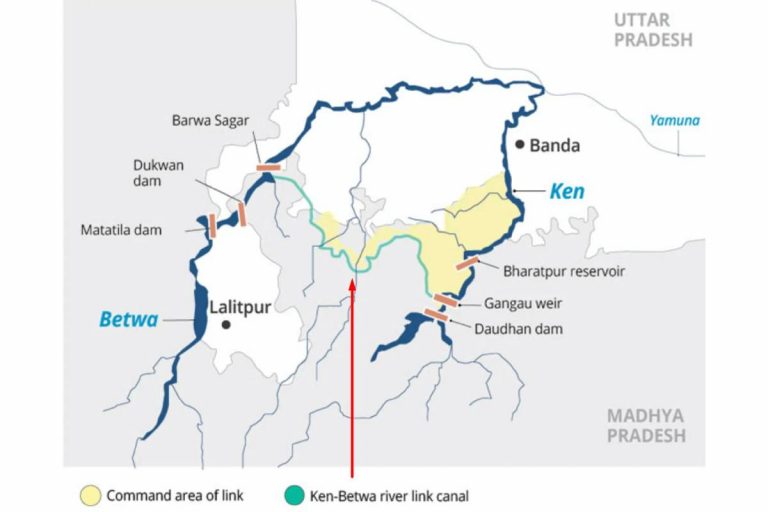
- 09 Jan 2025
Overview of the River Interlinking Concept
The concept of river interlinking in India traces its origins to the 19th century, when Sir Arthur Cotton first proposed inter-basin water transfer to address irrigation issues. Over time, this idea was refined by other experts. It evolved into the National Water Grid and, later, the River-Interlinking Project (ILR) under the Ministry of Water Resources. The goal is to transfer surplus water from rivers to drought-prone areas, aiming for water security, irrigation, and power generation.
Key Projects and Initiatives
- Ken-Betwa River Link Project (KBLP): Launched in December 2024, the KBLP will link the water-surplus Ken River with the drought-stricken Betwa River. It aims to irrigate over 10 lakh hectares, supply drinking water to 62 lakh people, and generate hydropower and solar power. However, concerns over the environmental impact of building a dam within the Panna Tiger Reserve have been raised.
- National River Linking Project (NRLP): The NRLP, formally known as the National Perspective Plan, is an ambitious proposal that includes 30 river links—14 Himalayan and 16 Peninsular—to connect India's rivers and create a giant South Asian Water Grid.
Benefits of Interlinking Rivers
- Flood and Drought Mitigation: Redistributing water from surplus areas to drought-prone regions, such as Bundelkhand, will reduce the severity of floods and droughts.
- Agriculture and Irrigation: Expanding irrigation systems across 35 million hectares of land could significantly boost agricultural productivity and food security.
- Hydropower Generation: The interlinking project has the potential to generate up to 34 GW of hydropower, contributing to India's renewable energy targets.
- Economic Growth: Improving water availability can boost industries, provide drinking water, and support economic development in underdeveloped regions.
- Inland Waterways: The project will also contribute to the expansion of inland waterways, benefiting trade and reducing transportation costs.
Challenges and Concerns
- Environmental Impact:
- Biodiversity Loss: Projects like the Ken-Betwa project raise alarms about the destruction of ecologically sensitive areas, such as the Panna Tiger Reserve.
- River Ecosystem Disruption: Altering natural river courses can harm aquatic life, disrupt deltaic ecosystems, and degrade water quality. For instance, the Sardar Sarovar Dam's impact on the Narmada river system shows the long-term consequences of such projects.
- Pollution: The mixing of cleaner and more polluted rivers could exacerbate water contamination issues.
- Social and Financial Costs:
- Displacement: Large-scale interlinking projects will displace millions, especially marginalized communities and indigenous people, and disturb local livelihoods.
- High Financial Burden: The total estimated cost of the NRLP is ?5.5 lakh crore, which does not include environmental rehabilitation costs or the long-term maintenance of the infrastructure.
- Climate Change: Predictions suggest that climate change could affect river flows and the availability of surplus water. This might render the interlinking project ineffective in the long term.
- Inter-State Conflicts: Water-sharing disputes, like the long-standing issues over the Cauvery and Krishna rivers, could intensify with more interlinking projects.
- Infrastructural Challenges: Maintaining vast canal networks and reservoirs, managing sedimentation, and acquiring land for construction are logistical hurdles.
Alternative Approaches and Solutions
- Efficient Water Management:
- Integrated Watershed Management: Implementing a comprehensive approach to manage existing water resources can reduce the need for large-scale river transfers.
- Groundwater Recharge: Focusing on efficient groundwater management by identifying recharge mechanisms and regulating water use is crucial for sustainability.
- Modern Irrigation Techniques:
- Drip Irrigation: Israel’s success with drip irrigation, which reduces water use by 25%-75%, provides an example of how modern technologies can save significant amounts of water.
- Virtual Water: Emphasizing the import of water-intensive goods (like wheat) could save local water resources, which would otherwise be used for domestic agriculture.
- National Waterways Project (NWP): An alternative to the interlinking project, NWP aims to improve water management by creating navigation channels that double as water distribution networks with a fraction of the land use.
Way Forward
- Comprehensive Impact Assessments: The need for multidisciplinary studies to evaluate the environmental, social, and economic impacts of river interlinking projects cannot be overstated. Stakeholder engagement is crucial for equitable decision-making.
- Sustainable Water Policies: A national water policy should prioritize sustainable water practices, focusing on local solutions, such as water harvesting, watershed management, and smart irrigation.
- Focus on Regional Solutions: Smaller, state-specific projects should be prioritized to address water scarcity issues without triggering large-scale environmental degradation.
The Impact of Climate Change on Earth’s Water Cycle
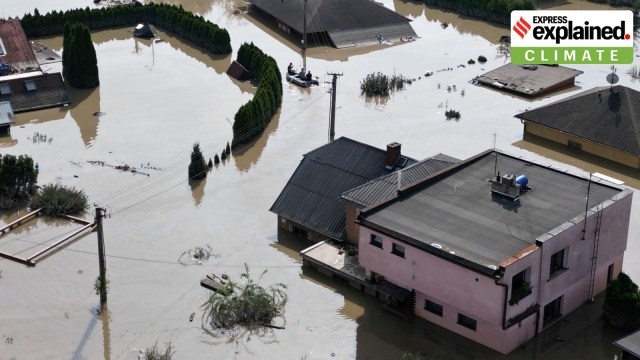
- 08 Jan 2025
In News:
Climate change is significantly affecting Earth's water cycle, leading to extreme weather events such as intense floods and prolonged droughts. According to the 2024 Global Water Monitor Report, this disruption is increasingly evident, as seen in the devastating weather patterns experienced worldwide in 2024. The report, based on data from international researchers, highlights how these changes are directly linked to rising global temperatures and the resulting shifts in precipitation patterns.
Understanding the Water Cycle
The water cycle is the continuous movement of water in various forms—solid, liquid, and gas—throughout the Earth's atmosphere, land, and bodies of water. This cycle involves processes such as:
- Evaporation: Water from the surface of oceans, lakes, and rivers turns into vapor.
- Transpiration: Water is absorbed by plants from the soil and released as vapor.
- Precipitation: Water vapor condenses into clouds and falls as rain or snow, replenishing the Earth's surface.
- Runoff and Infiltration: Precipitation either flows into rivers or infiltrates the soil, contributing to groundwater.
The water cycle is vital for maintaining the planet’s ecosystems, regulating weather patterns, and providing water for all living organisms. However, climate change is intensifying these natural processes, with far-reaching consequences.
Impact of Climate Change on the Water Cycle
As global temperatures rise, climate change is having a profound impact on the water cycle. Warmer temperatures lead to:
- Increased evaporation: As air temperatures soar, more water evaporates into the atmosphere. For every 1°C rise in temperature, the atmosphere can hold about 7% more moisture, which exacerbates storms and increases the intensity of rainfall.
- More intense precipitation: With more moisture in the atmosphere, storms have become more intense, leading to severe flooding in various regions.
- Increased droughts: Warmer air also dries out the soil. This reduces the amount of water available for crops and plants, while also increasing the evaporation rate from soil, leading to longer and more intense droughts.
This disruption of the water cycle is already causing erratic weather patterns, as some regions face severe droughts, while others are experiencing extreme rainfall and floods.
Key Findings from the 2024 Global Water Monitor Report
The 2024 report presents several alarming statistics that highlight the growing impact of climate change on the water cycle:
- Water-related disasters: In 2024, these disasters caused over 8,700 fatalities, displaced 40 million people, and resulted in economic losses exceeding $550 billion globally.
- Dry months: There were 38% more record-dry months in 2024 than the baseline period (1995-2005), underlining the growing frequency of droughts.
- Intense rainfall: Record-breaking rainfall occurred 27% more frequently in 2024 compared to 2000, with daily rainfall records set 52% more often. This shows the growing intensity of precipitation events.
- Terrestrial water storage (TWS): Many dry regions faced ongoing low TWS levels, reflecting the scarcity of water in these areas, while some regions, such as parts of Africa, saw an increase in water storage.
- Future predictions: Droughts may worsen in regions like northern South America, southern Africa, and parts of Asia, while areas like the Sahel and Europe could experience increased flood risks in the coming years.
Conclusion
The findings of the 2024 report underscore the alarming impact of climate change on the global water cycle. As temperatures continue to rise, we can expect more frequent and severe weather events, including extreme flooding and devastating droughts. These changes will affect billions of people worldwide, highlighting the urgent need for action to mitigate climate change and adapt to its consequences. Addressing this challenge requires global cooperation to reduce emissions, enhance water management systems, and protect vulnerable regions from the intensifying effects of climate change.
Implications of China’s Mega-Dam Project on the Brahmaputra River Basin
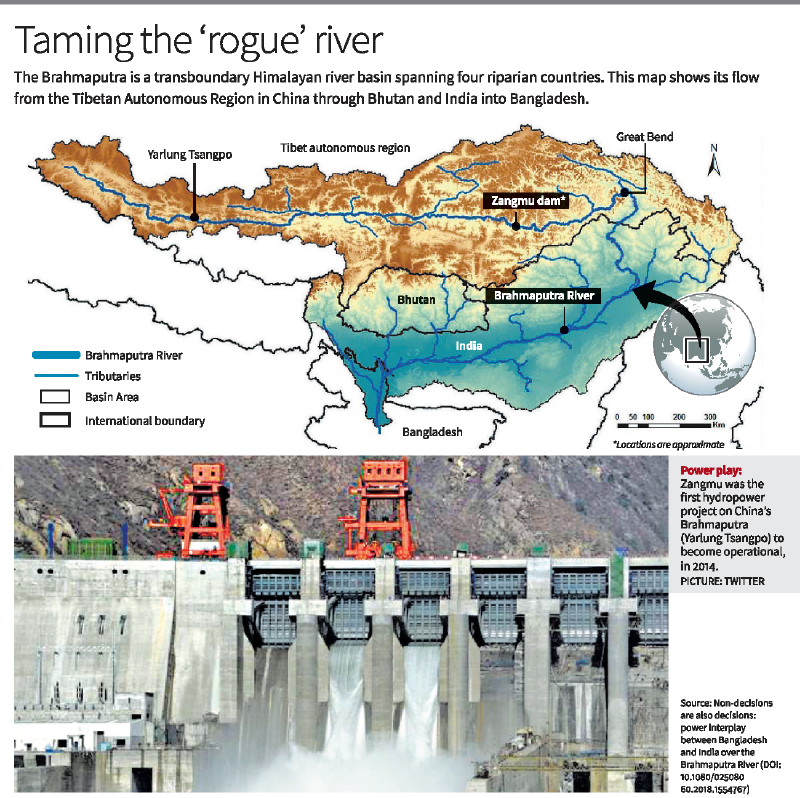
- 07 Jan 2025
Introduction:
China has approved the construction of the Yarlung Tsangpo hydropower project, the world's largest hydropower project, with a capacity of 60,000 MW, on the Brahmaputra River in Tibet. This mega-dam, located at the Great Bend in Medog county, has significant geopolitical, environmental, and socio-economic implications for India, Bhutan, and Bangladesh, the downstream riparian countries.
Geographical and Geopolitical Context:
- The Brahmaputra is a transboundary river system flowing through China, India, Bhutan, and Bangladesh.
- China, located at the river’s source in Tibet, is the uppermost riparian nation, controlling water flow into India and Bangladesh.
- All riparian countries, including China, India, Bhutan, and Bangladesh, have proposed major water infrastructure projects in the river basin, which has become a site for geopolitical rivalry, with mega-dams symbolizing sovereignty.
China’s Hydropower Ambitions:
- The Yarlung Tsangpo project is part of China’s 14th Five-Year Plan (2021-2025) and aims to address the country's energy needs while moving towards net carbon neutrality by 2060.
- The river's steep descent from Tibet provides an ideal location for hydroelectricity generation.
- China’s previous mega-projects, like the Three Gorges Dam, highlight the scale of these ambitions but also raise concerns about environmental and social consequences, including ecosystem disruption, displacement, and seismic risks.
Impact on Downstream Communities:
- Water Flow and Agriculture: China’s mega-dam may significantly alter water flow to India, particularly affecting agriculture and water availability in the northeastern regions. India, reliant on the Brahmaputra for irrigation and drinking water, could face disruptions.
- Silt and Biodiversity: The blocking of silt essential for agriculture could degrade soil quality and damage biodiversity in the river basin.
- Seismic Risks: The region’s seismic activity, coupled with the construction of large dams, heightens the risk of catastrophic events such as landslides and Glacial Lake Outburst Floods (GLOFs), which have previously caused devastation in the Himalayas.
Hydropower Competition Between China and India:
- Both China and India are competing to harness the Brahmaputra's potential for hydropower, with India planning its own large project at Upper Siang.
- Bhutan has also proposed several medium-sized dams, raising concerns in downstream countries about cumulative impacts.
- No comprehensive bilateral treaty exists between India and China to regulate shared transboundary rivers, though they have mechanisms for data sharing and discussions on river issues.
Environmental and Regional Concerns:
- The Brahmaputra river basin is an ecologically sensitive region. The construction of large dams threatens the fragile ecosystem, including agro-pastoral communities, biodiversity, and wetlands.
- Tibet’s river systems are vital for the global cryosphere, affecting climate systems, including monsoon patterns. Disruption to these systems could have broader implications for regional and global climate stability.
Challenges in Bilateral Cooperation:
- India and China have struggled with effective coordination on river management. China has shown reluctance to share critical hydrological data, a concern amplified by the lack of a binding agreement.
- The ongoing geopolitical tensions between the two countries, particularly over the border dispute, further complicate cooperation on transboundary water issues.
Recommendations for India:
- Enhanced Cooperation: India should push for renewed agreements and mechanisms for real-time data exchange with China to prevent ecological and socio-economic damage.
- Public Challenges: India needs to challenge China’s claims that its hydropower projects will have minimal downstream impact, ensuring that India's concerns are addressed in international forums.
- Diplomatic Engagement: Water issues should be prioritized in India’s diplomatic engagement with China, emphasizing the importance of transparency and cooperation to ensure mutual benefit and regional stability.
Conclusion:
The Yarlung Tsangpo mega-dam project poses significant risks to the entire Brahmaputra river basin. A collaborative approach, involving transparent dialogue and cooperation among riparian countries, is essential to mitigate the potential adverse impacts on downstream communities and the fragile Himalayan ecosystem.
NITI Aayog Celebrates 10 Years
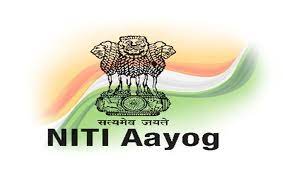
- 06 Jan 2025
In News:
- NITI Aayog, the National Institution for Transforming India, completed its 10th anniversary on January 1, 2025.
- Established to replace the Planning Commission, NITI Aayog was designed to address contemporary challenges such as sustainable development, innovation, and decentralization in a dynamic, market-driven economy.
About NITI Aayog
Establishment and Mandate
- Formation: Created through a Union Cabinet resolution in 2015.
- Primary Mandates:
- Overseeing the adoption and monitoring of the Sustainable Development Goals (SDGs).
- Promoting competitive and cooperative federalism between States and Union Territories.
Composition
- Chairperson: Prime Minister of India.
- Governing Council: Includes Chief Ministers (CMs) of all States and UTs, Lt. Governors, the Vice Chairperson, full-time members, and special invitees.
- CEO: Appointed by the PM for a fixed tenure.
Key Achievements
Policy Advisory and Decentralized Governance
- Shifted focus from financial allocation to policy advisory roles.
- Promoted decentralized governance through data-driven initiatives like the SDG India Index and the Composite Water Management Index.
Innovative Initiatives
- Aspirational Blocks Programme (2023): Focused on 500 underdeveloped blocks for 100% coverage of government schemes.
- Atal Innovation Mission (AIM): Trained over 1 crore students through Atal Tinkering Labs and incubation centres.
- Initiatives like e-Mobility, Green Hydrogen, and the Production-Linked Incentive (PLI) Scheme were conceptualized to drive innovation and sustainability.
Role and Functions of NITI Aayog
Strategic Advice and Federal Cooperation
- Provides policy formulation and strategic advice to both central and state governments.
- Fosters cooperative federalism by encouraging collaboration between the central and state governments.
Monitoring and Evaluation
- Plays a crucial role in monitoring and evaluating policies and programs to ensure alignment with long-term goals.
Promoting Innovation and SDGs
- NITI Aayog contributes to aligning national development programs with the Sustainable Development Goals (SDGs), focusing on innovation, research, and technology in critical sectors.
Key Differences Between Planning Commission and NITI Aayog
Aspect Planning Commission NITI Aayog
Purpose Centralized planning and resource allocation. Focus on cooperative federalism and policy research.
Structure Led by the PM, with Deputy Chairman and full-time members. Led by the PM, with Vice-Chairperson, CEO, and Governing Council.
Approach Top-down, centralized. Bottom-up, encouraging state participation.
Role in Governance Executive authority over policies. Advisory body without enforcement power.
Five-Year Plans Formulated and implemented. Focus on long-term development, no Five-Year Plans.
Challenges Faced by NITI Aayog
- Limited Executive Power: Lacks authority to enforce its recommendations, restricting its influence.
- Coordination Issues: Achieving effective collaboration between central and state governments remains challenging.
- Data Gaps: Inconsistent state-level data hampers accurate policymaking and evaluation.
- Resource Constraints: Limited resources hinder full implementation of initiatives.
- Resistance to Change: Some states resist NITI Aayog's initiatives due to concerns over autonomy and alignment with local needs.
Future Vision and Planning
- Agenda for 2030: Focus on achieving the Sustainable Development Goals (SDGs) in areas like poverty alleviation, education, healthcare, clean energy, and gender equality.
- Vision for 2035: NITI Aayog's 15-year vision document aims for sustainable, inclusive growth, with an emphasis on economic growth, social equity, and environmental sustainability.
- Innovation and Digitalization: Promotes digitalization and innovation through data-driven policymaking and regional focus on tribal and hilly areas.
Conclusion: Reflections on the First Decade
- Despite significant achievements, NITI Aayog’s influence remains limited by its advisory role and resource constraints.
- The shift away from centralized planning, evident since the dissolution of the Planning Commission, has sparked debate about the effectiveness of such a model in ensuring long-term development and inclusive growth.
Government Extends Special Subsidy on DAP

- 03 Jan 2025
In News:
The Indian government has decided to extend the special subsidy on Di-Ammonium Phosphate (DAP) fertilizer for another year, a decision aimed at stabilizing farmgate prices and addressing the challenges posed by the depreciation of the Indian rupee.
Key Government Decision
- Extension of Subsidy: The Centre has extended the Rs 3,500 per tonne special subsidy on DAP from January 1, 2025 to December 31, 2025.
- Objective: This extension aims to contain farmgate price surges of DAP, India’s second most-consumed fertilizer, which is being impacted by the fall in the rupee's value against the US dollar.
Fertilizer Price Dynamics and Impact
- MRP Caps on Fertilizers: Despite the decontrol of non-urea fertilizers, the government has frozen the maximum retail price (MRP) for these products.
- Current MRPs:
- DAP: Rs 1,350 per 50-kg bag
- Complex fertilizers: Rs 1,300 to Rs 1,600 per 50-kg bag depending on composition.
- Current MRPs:
- Subsidy on DAP: The subsidy includes Rs 21,911 per tonne on DAP, plus the Rs 3,500 one-time special package.
- Impact of Currency Depreciation:
- The rupee's depreciation has made imported fertilizers significantly more expensive.
- The landed price of DAP has increased from Rs 52,960 per tonne to Rs 54,160 due to the rupee falling from Rs 83.8 to Rs 85.7 against the dollar.
- Including additional costs (customs, port handling, insurance, etc.), the total cost of imported DAP is now Rs 65,000 per tonne, making imports unviable without further subsidy or MRP adjustments.
- The rupee's depreciation has made imported fertilizers significantly more expensive.
Industry Concerns and Viability Issues
- Import Viability:
- Fertilizer companies face significant cost pressures due to rising import prices and the current MRP caps.
- Without an increase in government subsidies or approval to revise MRPs upwards, imports will be unviable.
- Even with the extended subsidy, companies estimate a Rs 1,500 per tonne shortfall due to currency depreciation.
- Stock Levels and Supply Challenges:
- Current stock levels for DAP (9.2 lakh tonnes) and complex fertilizers (23.7 lakh tonnes) are below last year's levels.
- With inadequate imports, there are concerns about fertilizer supply for the upcoming kharif season (June-July 2025).
Government’s Strategy and Fiscal Implications
- Compensation for Imports:
- In September 2024, the government approved compensation for DAP imports above a benchmark price of $559.71 per tonne, based on an exchange rate of Rs 83.23 to the dollar.
- With the rupee falling below Rs 85.7, these previous compensation calculations have become outdated.
- Fiscal Impact:
- The extended subsidy will cost the government an additional Rs 6,475 crore. Despite this, political implications of raising the MRP are minimal, as only non-major agricultural states are facing elections in 2025.
Future Outlook and Priorities
- Immediate Priority: The government’s primary concern is securing adequate fertilizer stocks for the kharif season, focusing on ensuring sufficient imports of both finished fertilizers and raw materials.
- Balancing Factors: The government will need to navigate the complex balance of maintaining fertilizer affordability for farmers, ensuring the viability of fertilizer companies, and managing fiscal constraints.
As the subsidy extension is implemented, all eyes will be on the government's ability to ensure a stable supply of fertilizers while safeguarding both farmer interests and economic sustainability in the face of an increasingly challenging exchange rate environment.
Caste-Based Discrimination in Prisons

- 02 Jan 2025
In News:
The Union Ministry of Home Affairs has recently introduced significant revisions to the Model Prison Manual, 2016, and the Model Prisons and Correctional Services Act, 2023. These changes aim to eliminate caste-based discrimination in Indian prisons and establish a standardized approach to defining and treating habitual offenders across the country.
Background
In October 2024, the Supreme Court of India expressed concerns over the persistence of caste-based discrimination within prisons and the lack of consistency in how habitual offenders are classified. In response, the Court instructed the government to amend prison regulations to promote equality and fairness. The newly introduced reforms are in line with the Court's directives and focus on aligning prison practices with constitutional principles.
Addressing Caste-Based Discrimination in Prisons
The recent amendments take specific steps to combat caste-based discrimination within correctional facilities:
- Ban on Discrimination: Prison authorities are now mandated to ensure there is no caste-based segregation or bias. All work assignments and duties will be distributed impartially among inmates.
- Legal Provision Against Discrimination: A new clause, Section 55(A), titled "Prohibition of Caste-Based Discrimination in Prisons and Correctional Institutions", has been added to the Model Act, establishing a formal legal framework to address caste discrimination.
- Manual Scavenging Ban: The amendments extend the provisions of the Prohibition of Employment as Manual Scavengers and their Rehabilitation Act, 2013 to include prisons, prohibiting the degrading practice of manual scavenging or any hazardous cleaning within correctional facilities.
Redefining Habitual Offenders
The updated amendments also standardize the classification and treatment of habitual offenders, in accordance with the Supreme Court’s directions:
- Uniform Definition: A habitual offender is now officially defined as an individual convicted and sentenced to imprisonment for two or more separate offences within a continuous five-year period, provided the sentences were not overturned on appeal or review. Importantly, time spent in jail under sentence is excluded from this five-year period.
- National Consistency: States that do not have specific Habitual Offender Acts must amend their laws within three months to ensure consistency with the new national framework.
Importance of the Reforms
- Promoting Equality: These amendments seek to uphold the constitutional rights of prisoners, ensuring that all individuals, regardless of caste or background, are treated equally and with dignity.
- Eliminating Degrading Practices: The extension of the manual scavenging prohibition to prisons is a vital step in eliminating degrading and inhumane practices, ensuring a more humane environment for prisoners.
- Uniform Framework: The establishment of a standardized definition of habitual offenders ensures a consistent approach in handling repeat offenders across all states, reducing the possibility of arbitrary classifications.
Conclusion
The reforms introduced by the Union Home Ministry mark a significant milestone in India’s prison reform journey. By addressing caste-based discrimination and standardizing the classification of habitual offenders, these amendments reaffirm the country’s commitment to human rights and the rule of law. These changes not only improve the conditions within prisons but also set the stage for future reforms aimed at creating a fairer and more equitable correctional system.
